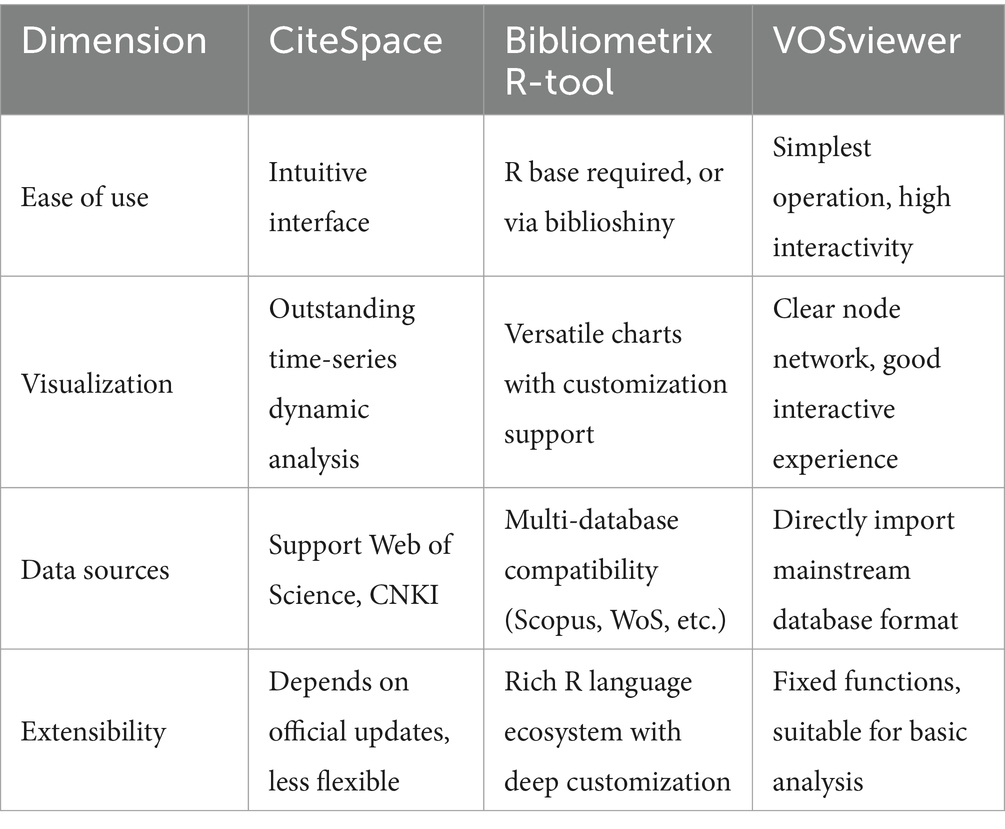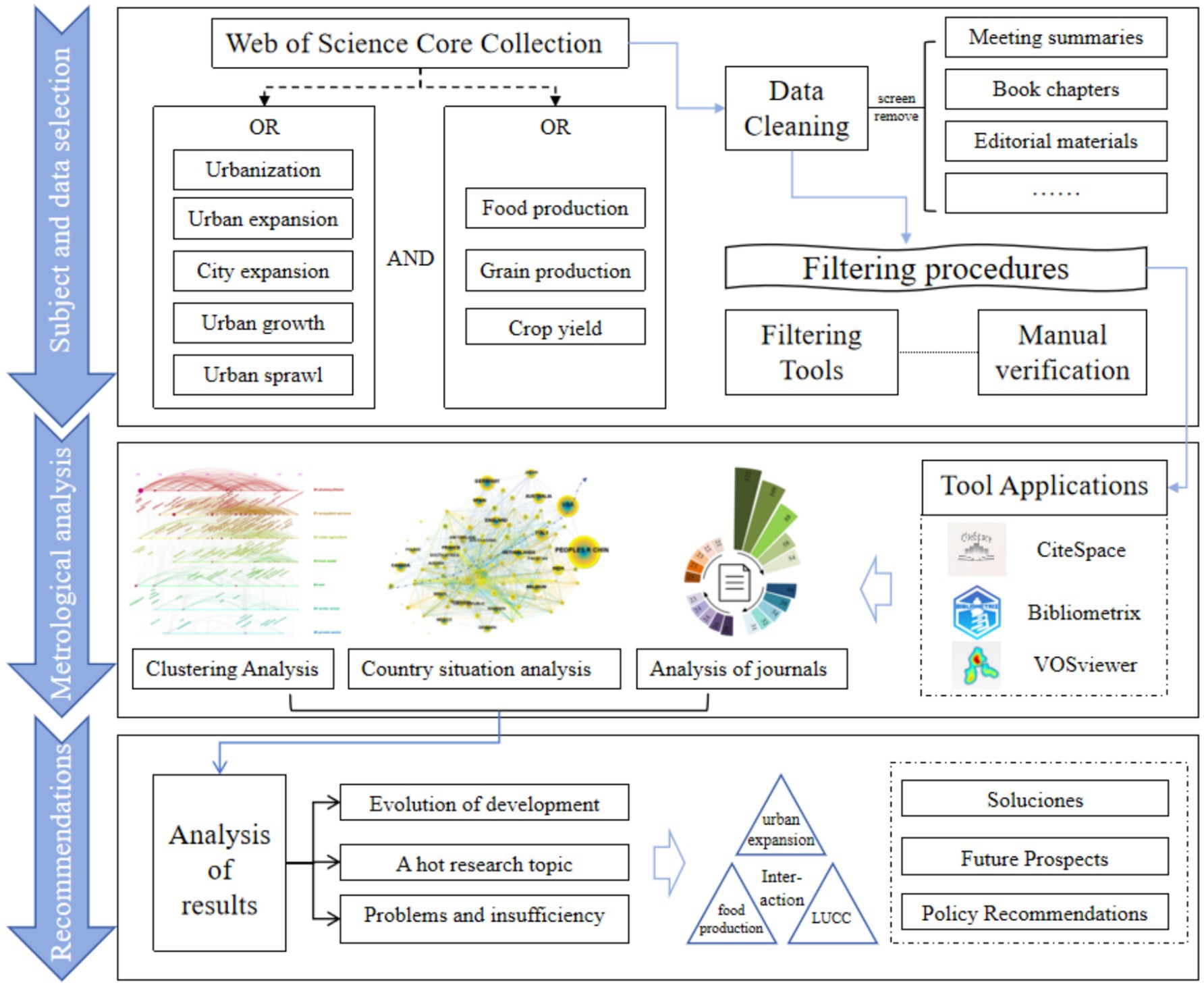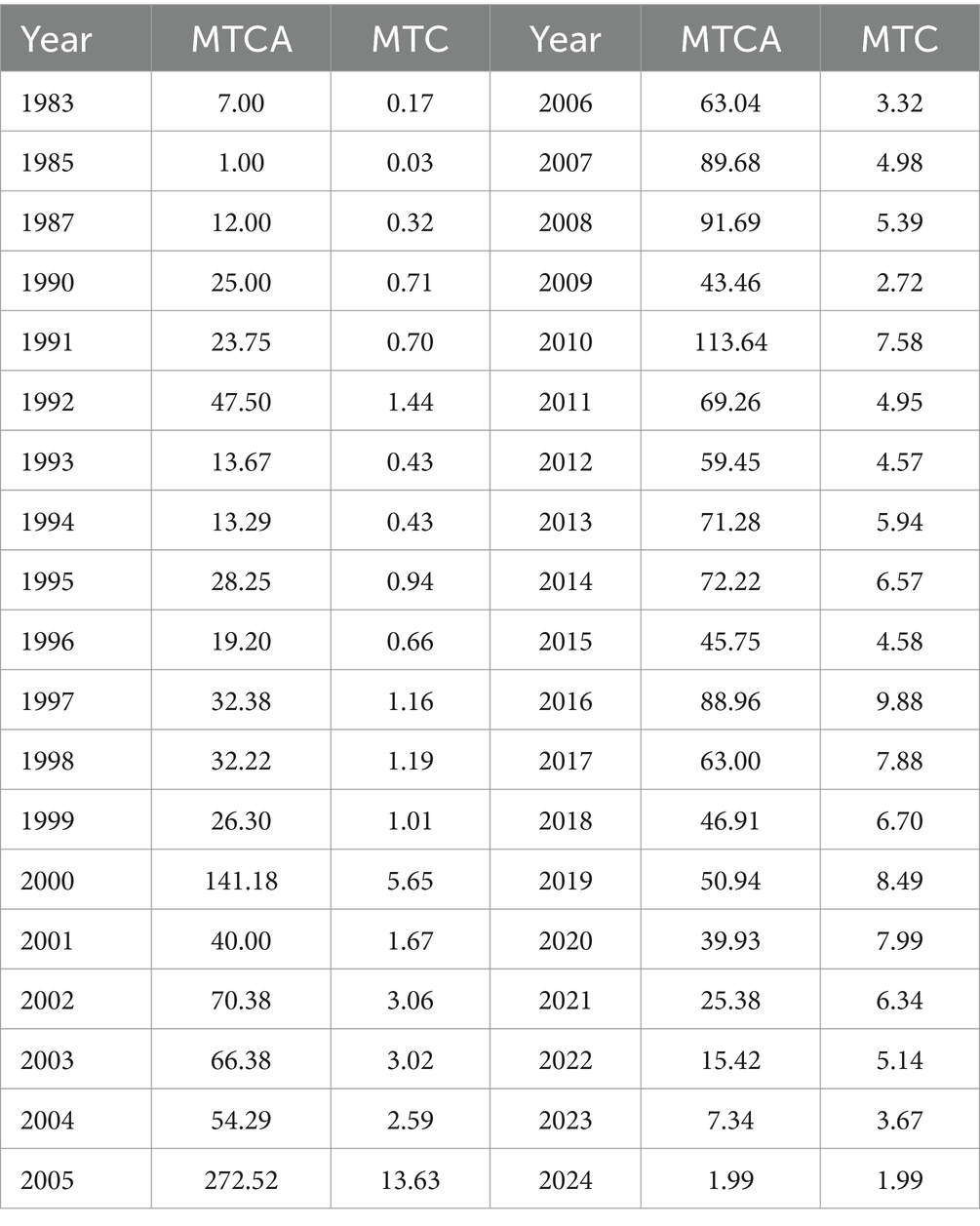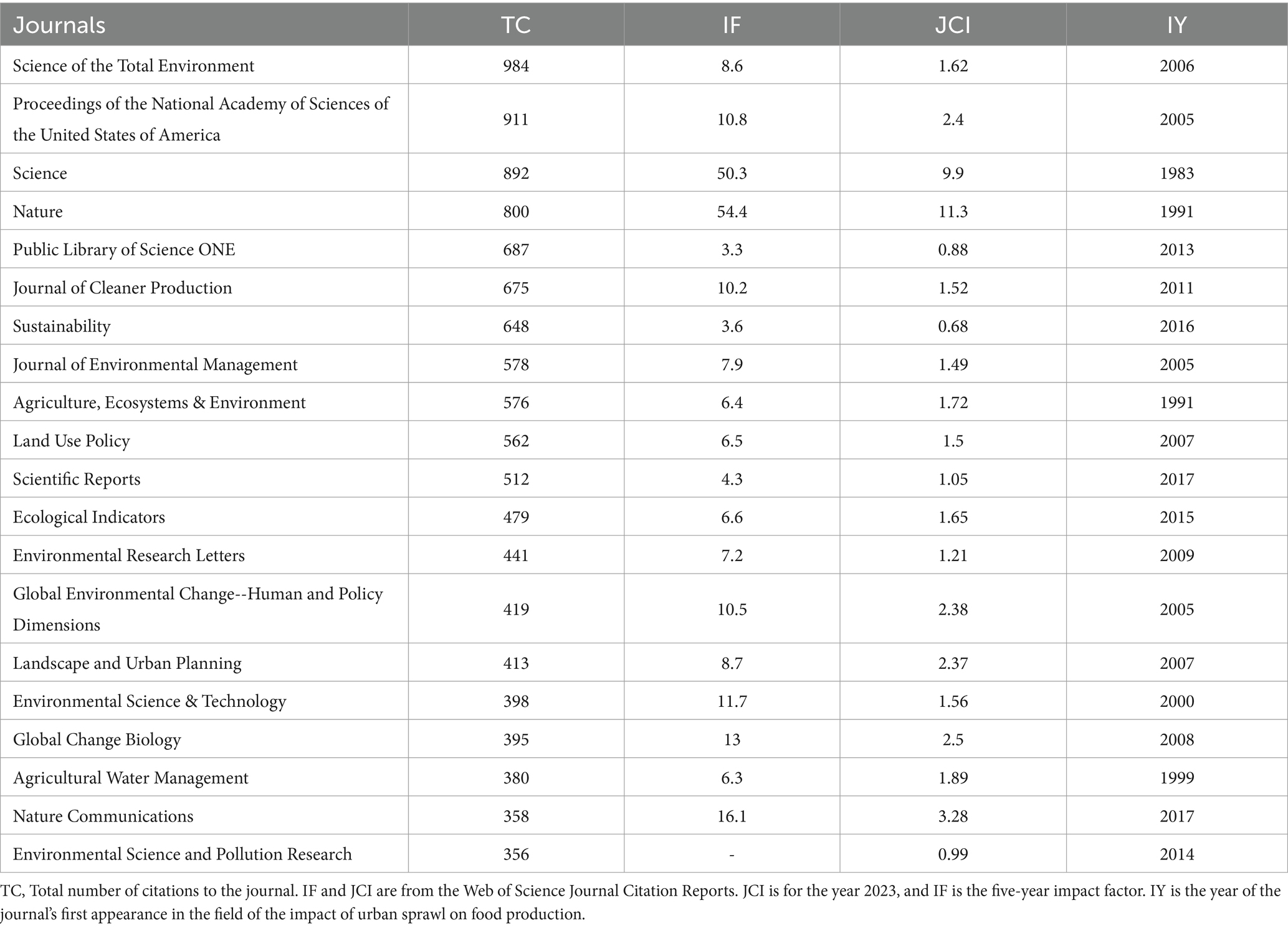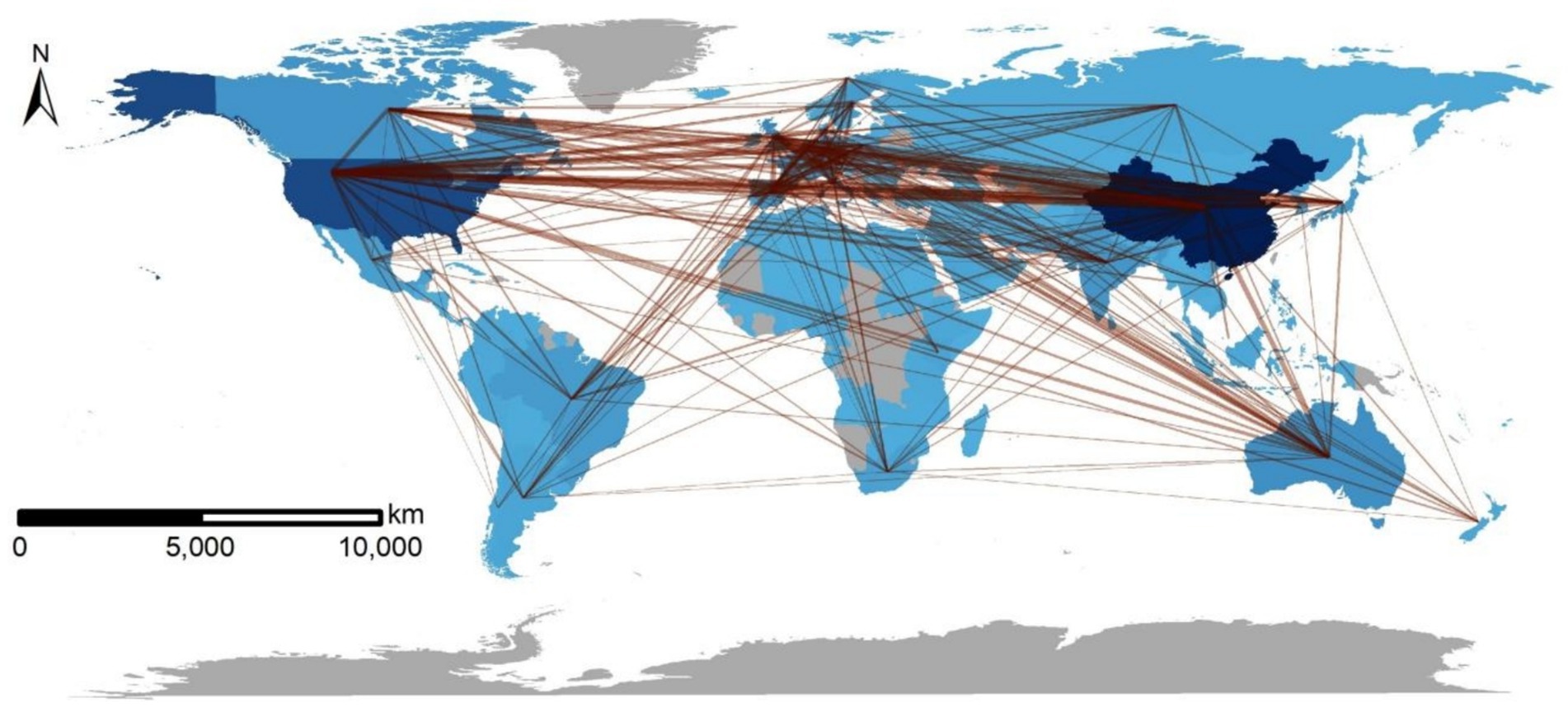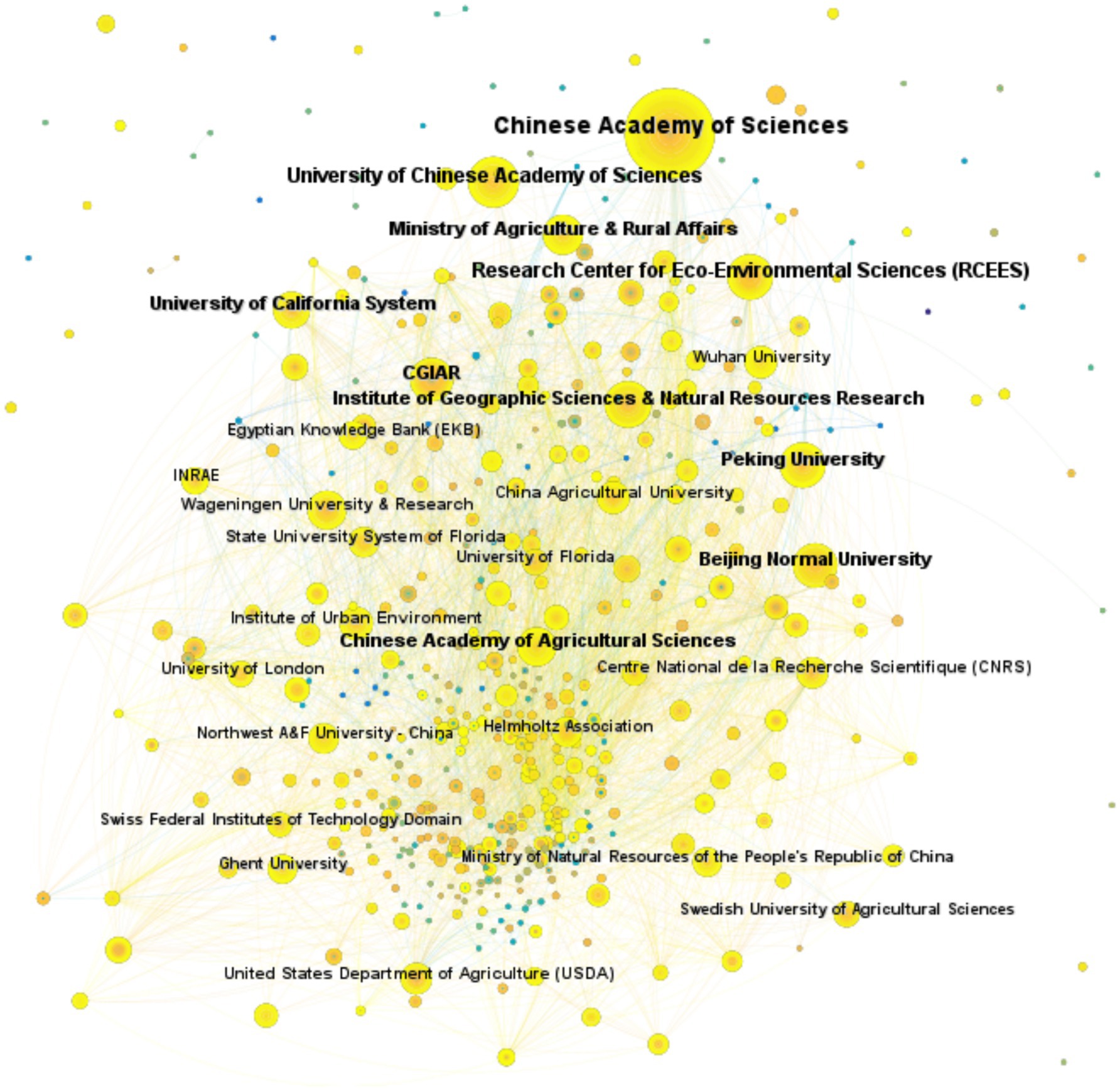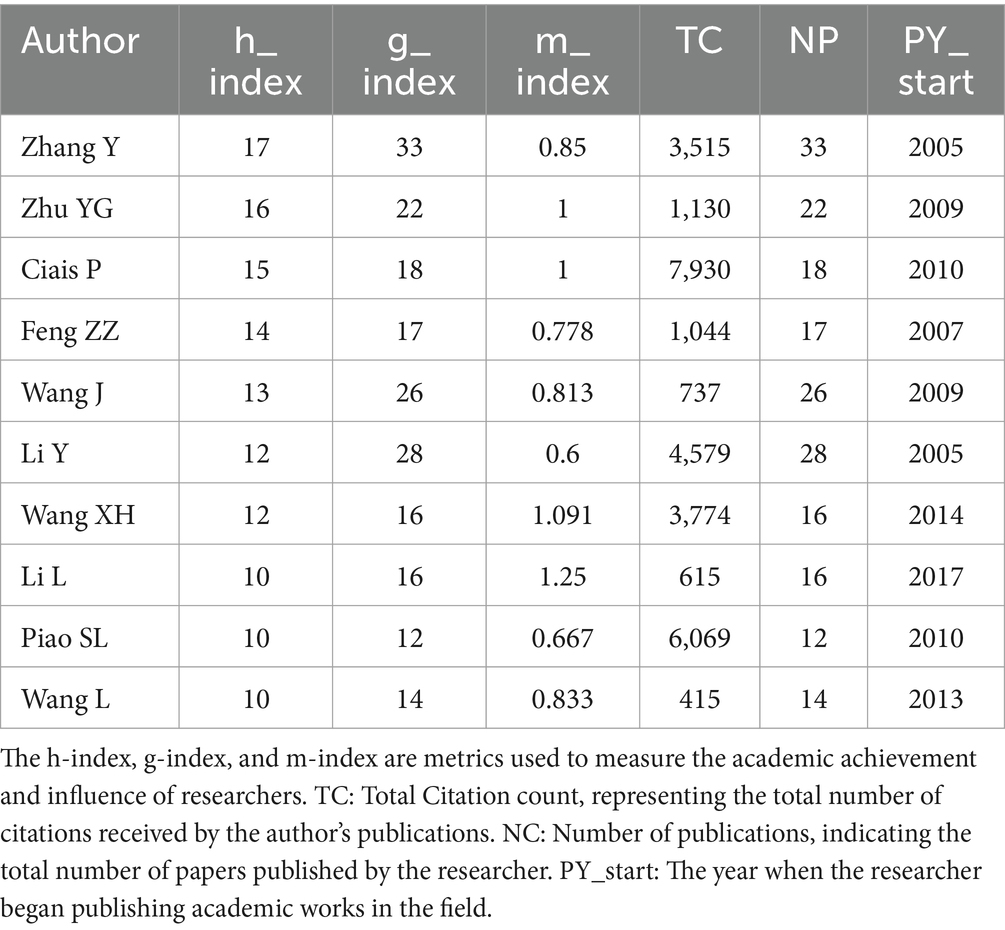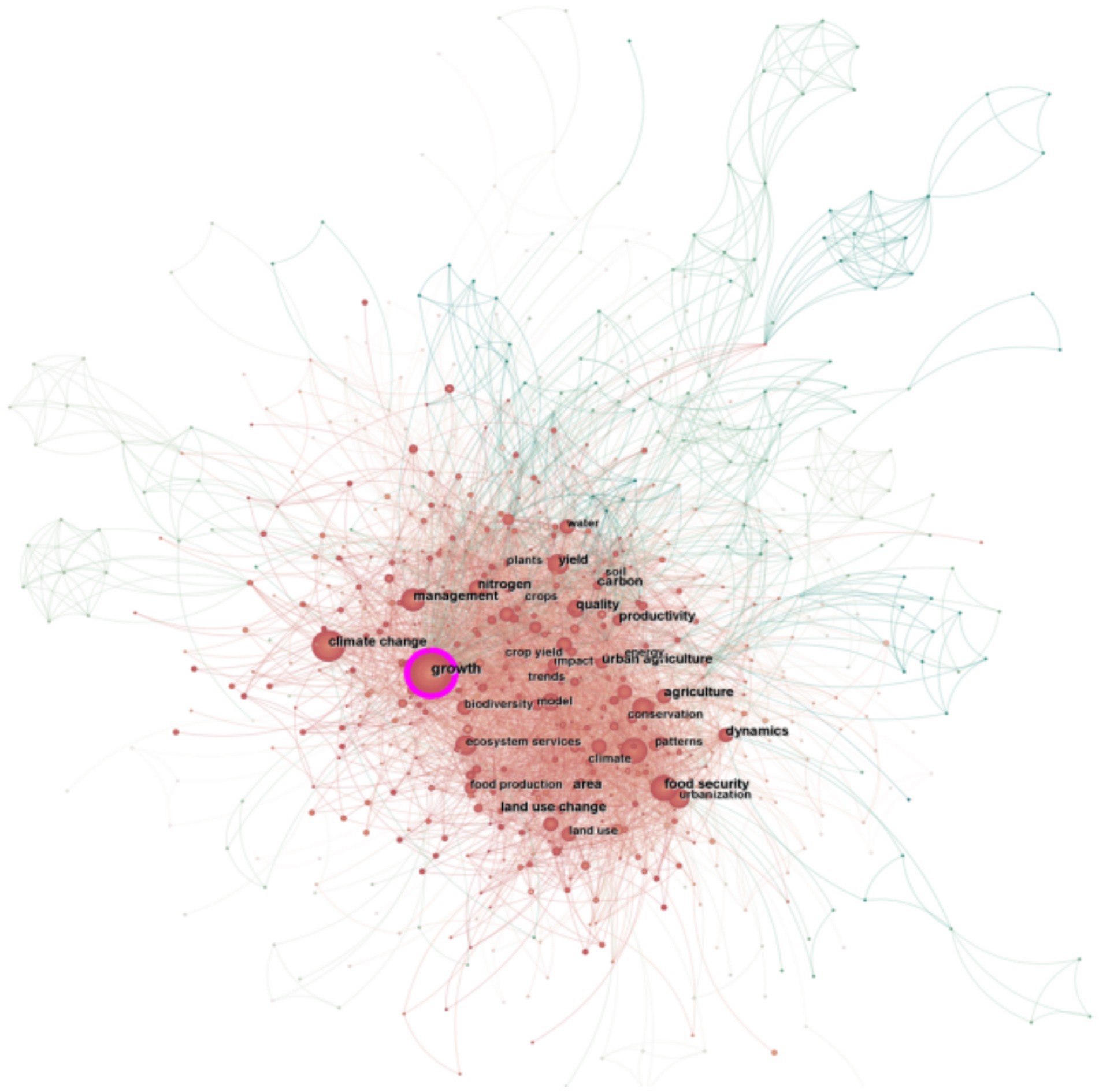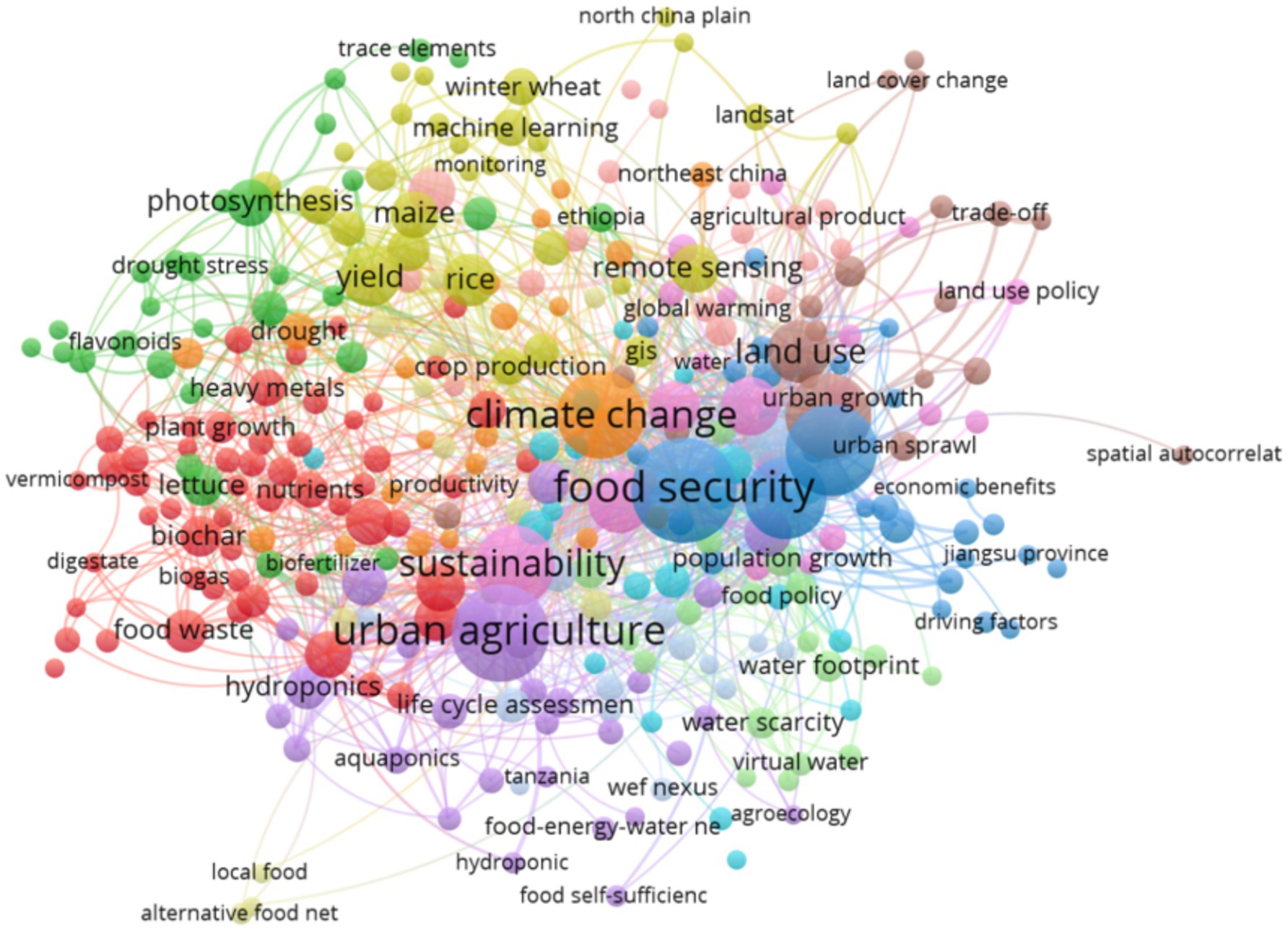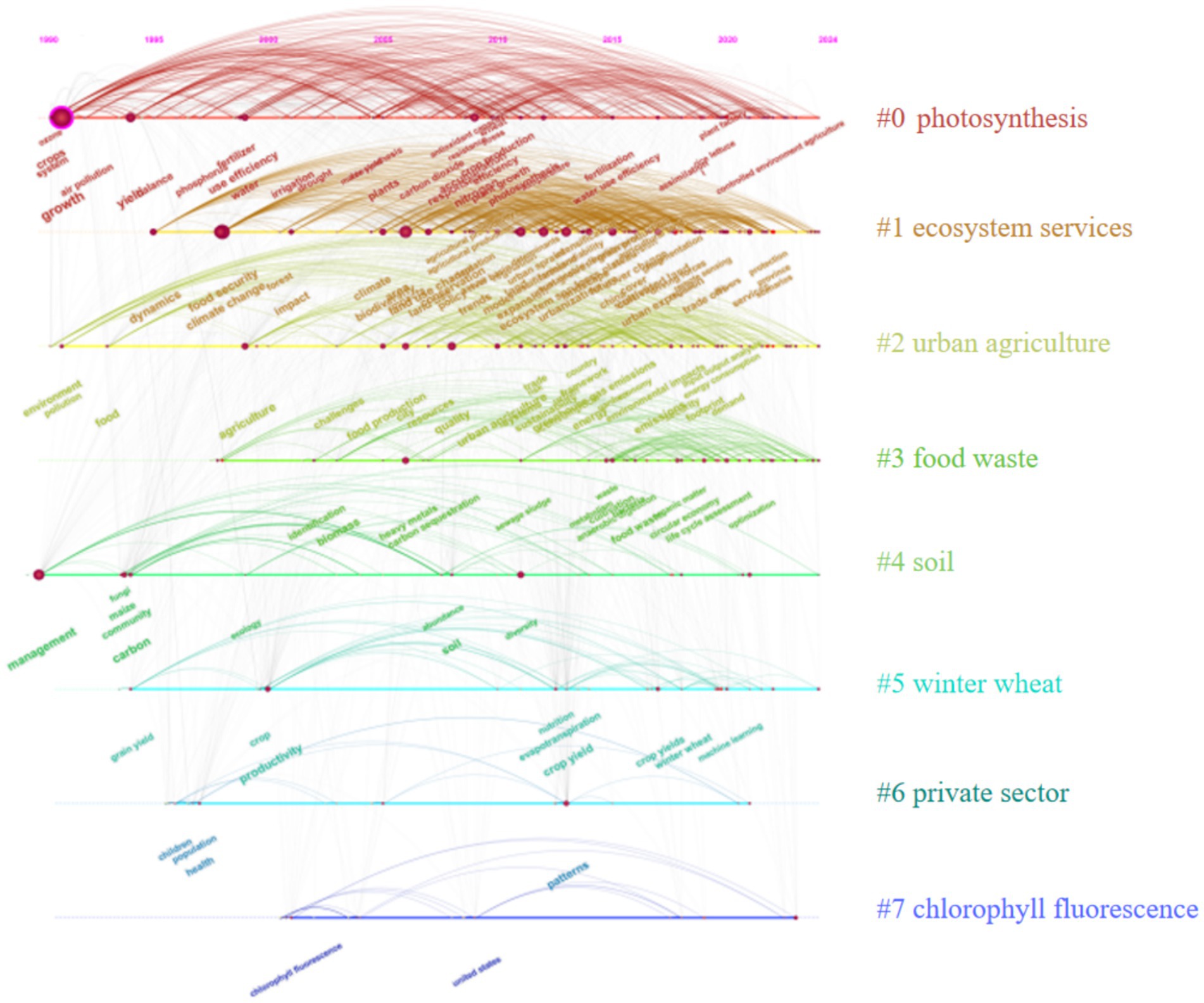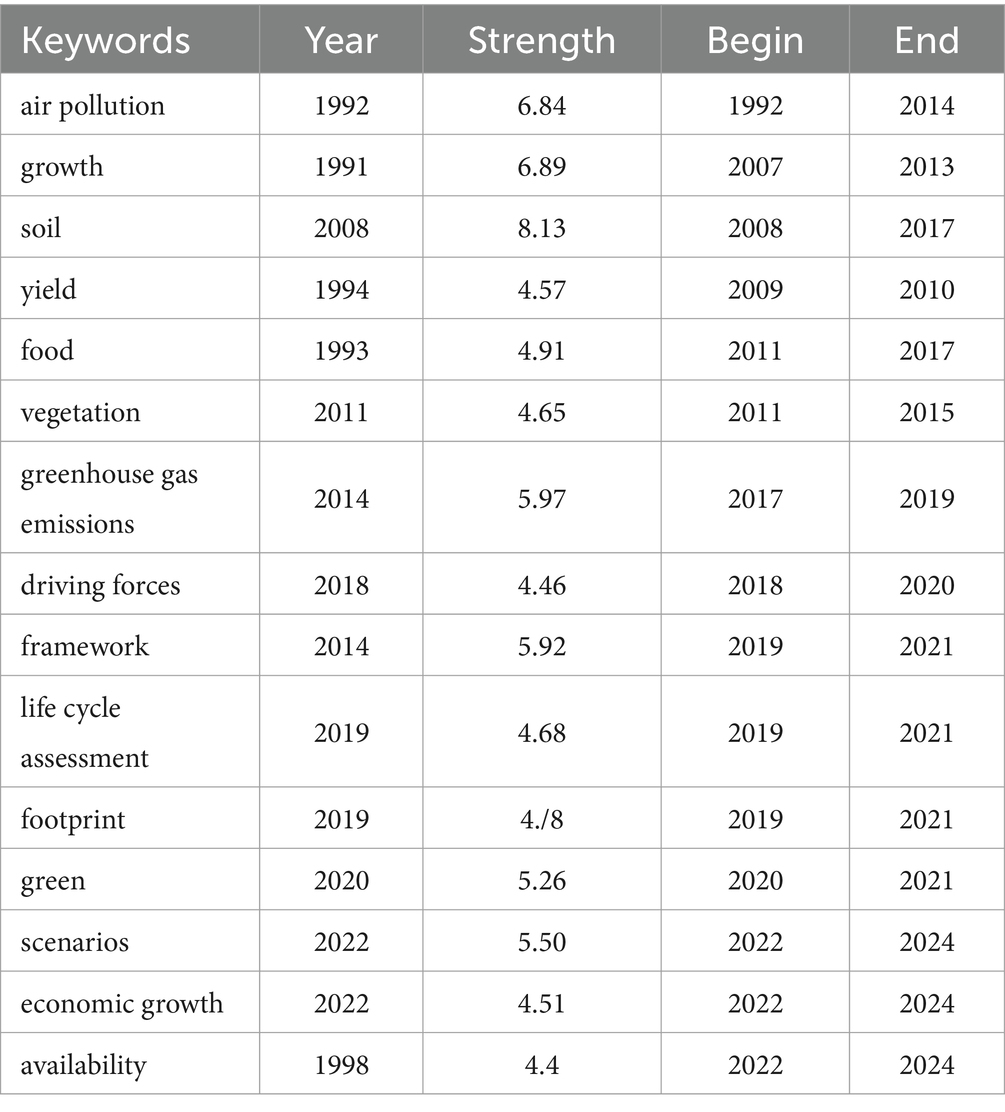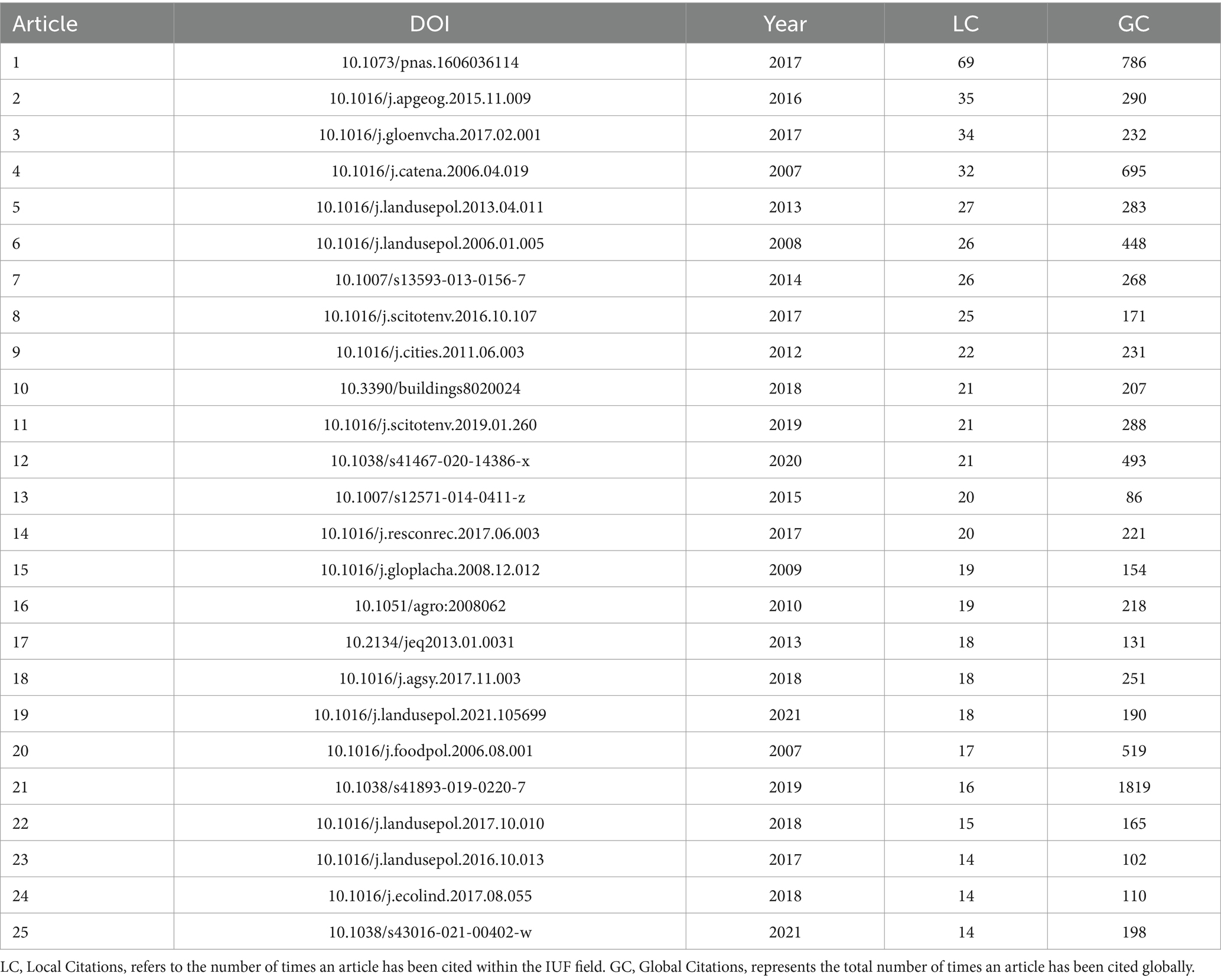- 1Faculty of Geographical Science, School of Natural Resources, Beijing Normal University, Beijing, China
- 2School of Land Science and Technology, China University of Geosciences, Beijing, China
The acceleration of urban expansion and rapid economic growth have significantly intensified agricultural land scarcity, jeopardizing global food security. Although this issue has become a key topic in global food security, a comprehensive and systematic literature review is still lacking. To systematically analyze the evolutionary patterns, research frontiers, and knowledge structure in this field, this study employs an integrated bibliometric approach using CiteSpace, VOSviewer, and Bibliometrix R-tool for comprehensive knowledge mapping. The results indicate that research on the impact of urban expansion on food production can be divided into an initial period (1983–1999), a period of rapid development (2000–2014), and a period of high growth (2015–present). One hundred thirty-nine countries have conducted research in this area. Research on greenhouse gases, simulation forecasting, carbon footprints, and smart agriculture has emerged as hotspots in this field in recent years. Crop yield, land use change, and food security have consistently been central research themes. This study also highlights future research directions, emphasizing the importance of interdisciplinary collaboration, scenario-based analysis, and methodological advancements in bibliometric studies. Balancing economic development with food production amid urbanization remains a critical challenge that warrants further exploration. Additionally, key limitations, such as database constraints and potential analytical biases, are discussed. These findings may serve as a valuable reference for future research in this domain.
1 Introduction
The world has experienced rapid urbanization. It is projected that the urban land area will expand to 3.6 million square kilometers by the year 2100 (Gao and O’Neill, 2020), and that by 2050, 68 percent of the global population will reside in urban areas (United Nations, 2018). Rapid urban development has exacerbated serious social and environmental problems, such as carbon emissions (Li et al., 2021), food security issues (Bren d’Amour et al., 2017), and biodiversity loss (Li G. et al., 2022). It has also intensified competition between urban land and other land uses (van Vliet et al., 2017). Urban expansion in many regions occurs at the expense of farmland (Munton, 2009; Wang Y. et al., 2019). Over 60% of the world’s irrigated farmland is adjacent to urban areas, highlighting intensified competition between agricultural and urban land uses (Thebo et al., 2014). Traditional agricultural patterns and food security face serious threats as an increasing amount of farmland is appropriated (Yang and Song, 2023; Zhang et al., 2017). Empirical studies indicate that approximately 50–63% of newly expanded urban areas are expected to emerge from existing croplands, resulting in a 1–4% decline in global food production, equivalent to the annual food needs of 122–1,389 million people (Chen et al., 2020). This trend is particularly evident in Asia, Africa, and South America, where rapid urbanization and escalating competition between agricultural land and urban expansion are most pronounced (van Vliet et al., 2017).
The impact of urban expansion on food production is mainly achieved through various internal mechanisms and pathways. From the perspective of land resources, urban expansion directly encroaches on a large amount of high-quality cultivated land, reducing the area for food cultivation (Li et al., 2018). Meanwhile, infrastructure construction and industrial pollution during the urban construction process can alter the physical and chemical properties of the surrounding farmland soil. Additionally, they consume the priority soil types that feature high land capacity and high potential farmland productivity (Salvati, 2013). This significantly reduces the soil quality as well as the yield and quality of crops. From the water-resource perspective, urbanization brings about a sharp increase in water demand, which in turn impacts water quality and causes a decline in water security (da Encarnação Paiva et al., 2020). Moreover, global climate change amplifies the negative impacts of urban expansion on food production. For example, rising temperatures could lead to an 8–14% decrease in global maize yields, while urban expansion alone may contribute to a 1–3% reduction in maize production (Bassu et al., 2014; Chen et al., 2020). Additionally, urban expansion has a tendency to encroach upon high-yielding farmland and farmland with low blue water intensity (BWI). This situation exacerbates the competition for agricultural irrigation water, ultimately influencing food production (Wang, 2020).
An increasing number of studies have examined the impact of urban sprawl on food production in recent years, with assessments conducted by scholars at varying scales. Bren d’Amour et al. (2017) predict that urban expansion will result in a global loss of 1.8–2.4% of agricultural land by the year 2030, with the majority (80%) of this loss anticipated in the Asian and African regions. And, the loss of crop yields due to urban land expansion affects the annual demand for food of about 122–1,389 million people (Chen et al., 2020). A study conducted by He et al. (2017) revealed that the rapid urban sprawl exerted pressure on food security in China between 1992 and 2015, resulting in a 2% decline in the average annual food self-sufficiency. Additionally, uncontrolled low-density urban sprawl in the arid region of central Iran has been associated with the fragmentation of farmland and diminished crop yields (Nadoushan, 2022). Although urban sprawl presents challenges to food production, the adverse effects on food production may be mitigated through the implementation of effective land management strategies (Li et al., 2023; Wang S. et al., 2021). Relevant researchers are capable of formulating appropriate land use policies to safeguard prime agricultural land dedicated to the cultivation of key food crops (Andrade et al., 2022).
Despite the growing interest in the impact of urban sprawl on food production, the existing body of research is limited in its provision of thorough analyses. While numerous scholars have contributed to this field (Gren and Andersson, 2018; van Vliet et al., 2017), yet only a limited number of studies have undertaken systematic reviews and surveys, which poses challenges in effectively assessing key advances and insights. In the face of the exponential growth in the number of publications globally, researchers have found it increasingly challenging to maintain awareness of the relevant literature within their field. The acquisition of comprehensive and accurate information, as well as its efficient and rapid extraction, has become imperative (Liu et al., 2023; Silvente et al., 2018). Bibliometric analysis regards the literature system and bibliometric characteristics as the objects of study, employing mathematical, statistical, and other quantitative methods to analyze the distributional structure and quantitative relationships within the literature of a research domain. This approach aims to elucidate trends in scientific development and to identify potential research hotspots in the future (Garfield, 1964; Saini et al., 2023).
Numerous bibliometric software packages and tools have been developed, including CiteSpace (Chen et al., 2023), VOSviewer (Xiao et al., 2024), HistCite (Bornmann and Marx, 2012), and the Bibliometrix R-tool (Rodríguez-Soler et al., 2020). These instruments are extensively utilized across a range of disciplines including environmental science (Li B. et al., 2022), management (Ding et al., 2022), ecology (Picone et al., 2021), medicine (Zhang et al., 2024), computer science (Pan et al., 2018), among others, and are employed to uncover research hotspots and trends within particular subject domains. Bibliometric tools are capable of constructing knowledge graphs that visualize bibliometric data, thereby compensating for the limitations of conventional metrics analysis (Chen et al., 2008). For instance, functionalities like keyword co-occurrence, publication statistics, and cluster mapping can pinpoint key researchers and institutions across various disciplines, evaluate the research productivity of a field or topic, and are crucial in long-term bibliometric analyses. However, reliance on a single bibliometric tool may lead to biased data processing, monolithic analysis outcomes, and limited visualization effectiveness. Cheng et al. (2023) employed a combination of CiteSpace and VOSviewer bibliometric software for a systematic examination of food safety and carbon emissions. Similarly, San-Juan-Heras et al. (2024) utilized VOSviewer and Bibliometrix R-tool for a scientometric analysis of cover crop management. The integration of these two analytical tools has gained widespread acceptance among researchers across various disciplines (Li et al., 2024; Long et al., 2024; Yang et al., 2023). This study leverages the strengths of CiteSpace, VOSviewer software and the Bibliometrix R-tool, which serve as effective tools for investigating the field of the impact of urban expansion on food production (IUF). The integration of these tools facilitates the analysis of research priorities and trends within this specific domain.
This study aims to: (1) conduct a comprehensive assessment of the IUF dataset’s fundamental attributes using the Web of Science Core Collection database, encompassing publication frequency, citation count, and the number of articles in prominent journals; (2) pinpoint the key research strengths in the domain, involving prominent countries, institutions, influential scholars, and their collaborative networks; (3) reveal and contrast the evolution of research hotspots, elucidating the shifts in research focus over different periods; (4) examine the current landscape and hotspots of research, and forecast future trends. These in-depth analyses intend to chart a course for investigating the effects of urban sprawl on food production and to furnish decision-makers with insights for ensuring food security and the sustainable governance of urban spaces.
2 Materials and methods
2.1 Data collection
To guarantee publication quality, the Web of Science Core Collection (WOSCC) was utilized as the primary data source. This database encompasses over 20,000 journals of significant academic prestige and global impact, spanning diverse scholarly disciplines including natural sciences, engineering, technology, social sciences, and humanities (Wei et al., 2024). The database further captures essential bibliometric data, including titles, authors, keywords, affiliations, references, and more (Huang et al., 2020). This study focuses on the impact of urban expansion on food production (IUF). Record filtering in WOSCC is performed using specific terms and Boolean operators: TS (Topic search) = (“Urbanization” OR “Urban expansion” OR “City expansion” OR “Urban sprawl” OR “Urban growth”) AND (“Food production” OR “Grain production” OR “Crop yield”). To date, 4,234 records have been extracted from the WOSCC database, with the data exported as plain text files following the selection of the “complete records and cited references” option.
To ensure high-quality data, a more rigorous screening process was implemented. First, only peer-reviewed journal articles were included, while conference abstracts, book chapters, editorial materials, and other informal publications were excluded to minimize the influence of low-quality literature. Second, a dual screening mechanism was implemented. The first round involved automatic de-duplication and filtering using data cleaning tools provided by CiteSpace, Bibliometrix R-tool, and VOSviewer to remove duplicates and irrelevant records (e.g., editorial materials and book chapters). The second round consisted of a manual review conducted by the research team to ensure the scholarly value and relevance of the selected data, thereby enhancing their authority and representativeness. As a result of this screening process, 2,803 high-quality documents covering data from 1980 to early December 2024 were obtained. The research team then analyzed the dataset. These refinements have strengthened the reliability of the analytical results and mitigated uncertainties arising from biases in the data sources.
2.2 Methods
2.2.1 Application of tools
CiteSpace software (Chen, 2018), the Bibliometrix R-tool (Aria and Cuccurullo, 2017) and VOSviewer (Li B. et al., 2022) were utilized for the analysis of the database in this research (Table 1). CiteSpace, a Java-based software, is used for metro-logical analysis and knowledge mapping. It aids researchers in understanding the knowledge structure, research frontiers, and intertopic research relationships within a field (Wang X. et al., 2021). Bibliometrix R-tool, an R tool available at http://www.bibliometrix.org, facilitates the quantitative analysis of scientific literature. This reveals the maturity of scientific fields, prominent authors, conceptual and knowledge maps, as well as research trends (Rodríguez-Soler et al., 2020). VOSviewer (Xiao et al., 2024) is renowned for its intuitive node networks and dynamic interactive features, enabling users to efficiently identify research hotspots and knowledge structures.
CiteSpace facilitates time-series analysis, unveiling the evolution of research hotspots. The Bibliometrix R-tool offers robust bibliometric statistics, enabling an efficient analysis of research output at the author, institutional, and national levels. Meanwhile, VOSviewer serves as a powerful visualization tool for mapping academic collaborations and co-citation networks. The conceptual model presented in this article is illustrated in Figure 1. The utilization of both Bibliometrix R-tool, CiteSpace software and VOSviewer enables the full exploitation of their resources for bibliometric analysis, yielding more comprehensive and in-depth outcomes. These tools have furnished valuable insights and a reliable reference for the ongoing investigation of the knowledge base within this field.
2.2.2 Methods of analysis
1. Mediator centrality. This centrality measure quantifies the significance of a node within a network by indicating the degree to which the node serves as a bridge on the shortest paths between other nodes. Nodes in collaborative networks are deemed significant when their mediator centrality surpasses 0.1, indicative of their pivotal role in bridging other nodes. The calculation is represented by Equation 1 (de Castilhos Ghisi et al., 2020):
where denotes the number of shortest paths from node j to node k, and is the number of paths that pass through node i.
1. Lotka’s law: This law elucidates the correlation between the frequency of scientific publications by authors and the quantity of those publications, commonly referred to as the “inverse square law.” The calculation is represented by Equation 2 (Lotka, 1926):
In the aforementioned equation, A(n) represents the number of authors who have published n papers, whereas A(1) denotes the number of authors who have published only one paper.
1. Co-authorship analysis was conducted using indicators including Most Cited Papers with Coauthors from Other Countries (MCP) and Most Cited Papers with Coauthors from the Same Country (SCP) to examine the collaborative relationships between nations and the influence of such collaborations on academic achievements. These indicators are utilized to evaluate the position and influence of various countries within international and national academic cooperation networks, thereby further investigating the trends in academic collaboration. Additionally, the bibliometric study on the impact of urban sprawl on food production employed analytical methods such as coupling analysis (Kessler, 1963), cluster analysis (De Bem Machado et al., 2022), and co-citation analysis (Peters and Van Raan, 1991).
3 Results
3.1 Basic characteristics
3.1.1 Publication and citation analysis
Annual fluctuations in the number of publications and citations serve as crucial indicators for tracking the progression of research within a given field (Wei et al., 2024). As depicted in Figure 2, the publication volume within the field of urban sprawl’s impact on food production exhibits fluctuating growth patterns when examining inter-annual variations in relevant indicators. This study categorizes the research period in this domain based on its developmental trajectory into the initial phase (1983–1999), the phase of rapid expansion (2000–2014), and the current phase of high growth (2015–present). From 1983 to 1999, the number of publications in the field of IUF was relatively low, with a slow growth rate. In 1983, only one paper was published, and in 1984, no paper was released. From 1985 to 1989, the annual number of publications fluctuated between 2 and 4. The total number of documents published during this period was 64. From 2000 to 2014, the number of published papers increased rapidly. The number of papers published in 2000 was 11, which was higher than that in 1999. The total number of published papers during this period was 448, with an average annual number of approximately 32.07. The growth rate (compared with the previous period) reached 695.1%. This suggests that research efforts within the field of IUF have intensified, potentially influenced by advancements in technology, policy endorsements, or enhanced international collaborations, which have fueled the swift progression of research. From 2015 to the present, the cumulative number of publications and the annual number of publications have continued to grow rapidly. The number of publications in 2022 and 2023 was 371 and 341, respectively. The cumulative number of publications has reached 2,291, with an average annual number of approximately 255.22. The growth rate and scale of publications in this stage have increased significantly compared to the previous two stages, suggesting a rising interest in this field. This trend may indicate its increasing recognition as a research hotspot.
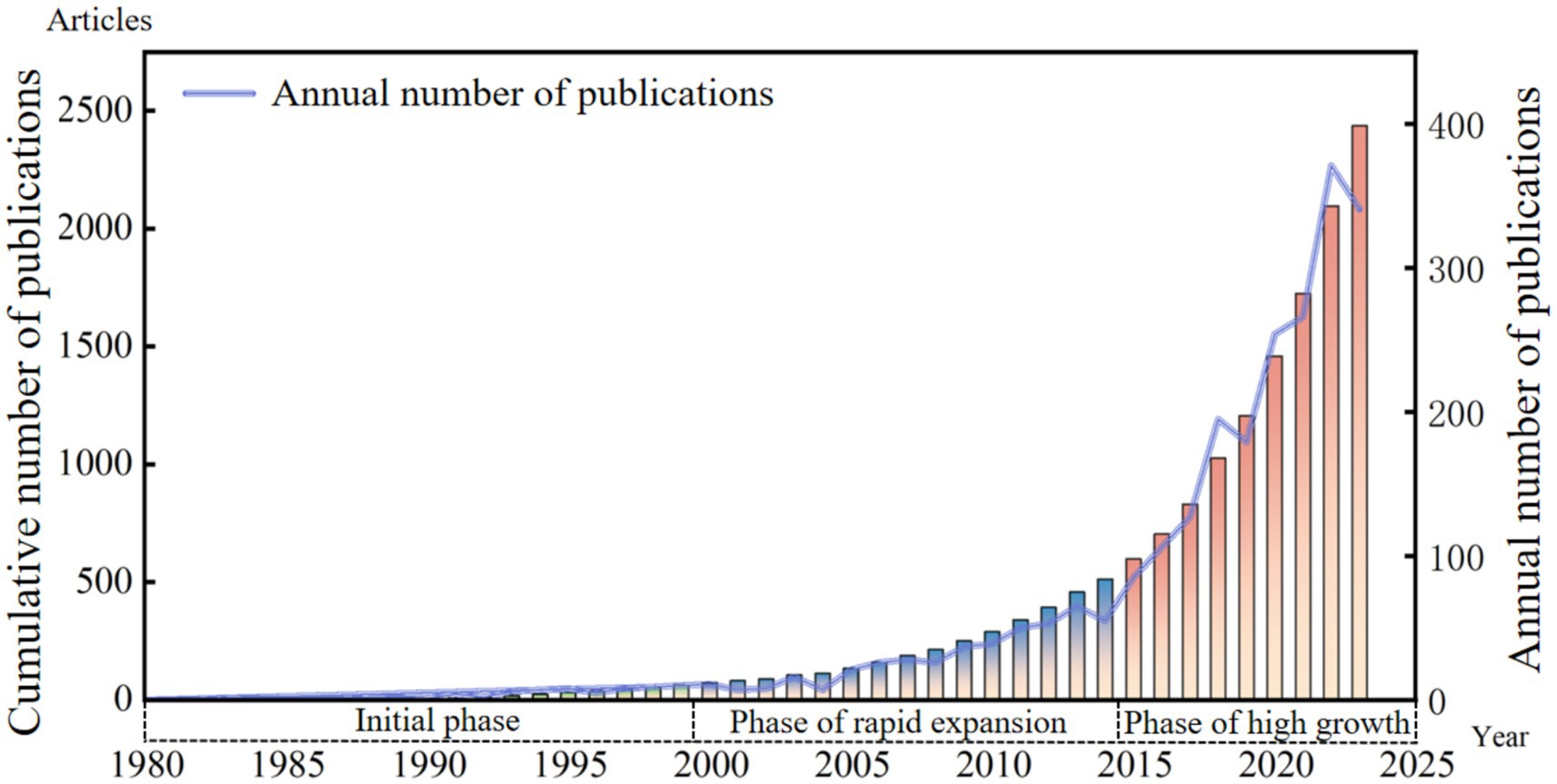
Figure 2. Publication trends in urban expansion’s impact on food production literature. The graph depicts the number of publications in the field up to early December 2024.
The average number of citations per article for the initial half of the 1983–2024 period is reported as 52.25 (Table 2). The peak MTCA (Mean Number of Citations per Article per Year) value was observed in the year 2000, amounting to 141.18, whereas the minimum value was recorded in 1985 (MTCA of 1). As anticipated, the mean MTC (Mean Number of Citations per Year) value was merely 0.71 during the initial phase, with a gradual increase observed during the period of rapid growth, resulting in a mean MTC value of 5.04. In the high growth phase, the mean MTC value had risen to 6.27, with the highest value being recorded in 2016 (9.88). These data demonstrate that research on urban expansion’s impact on arable land production is increasingly recognized as authoritative and influential.
3.1.2 Analysis of journals
The 2,810 relevant articles analyzed in this study were published in 863 journals. The top five journals most pertinent to the field of IUF include the Journal of Cleaner Production, Sustainability, Science of the Total Environment, Land, and Land Use Policy, which published 122, 109, 88, 58, and 54 articles, respectively (Figure 3). These journals encompass the disciplines of environmental science, sustainable development, ecology, and associated social sciences, thereby illustrating the multidisciplinary intersection and the diversity of research within the field.
The total number of citations (TC) for a journal serves as an indicator of its influence within the scientific community (Table 3). “Science of the Total Environment” is the most frequently cited journal in the IUF field, with a total of 984 citations. Among the top 20 journals by citation count, “Science” was the first to appear (in 1983) and has accumulated 892 citations. In contrast, “Nature” has a relatively low number of publications in the field (only 6), yet it ranks fourth in terms of citation count.
3.2 Research capacity
3.2.1 Country situation analysis
A total of 139 countries have engaged in research related to the IUF domain. Figure 4 illustrates the trend in academic collaboration among countries researching the impact of urban expansion on food production. Overall, the connections between countries intensify and become more complex throughout the study period, indicating an increase in the frequency of collaborative research efforts among countries. In the initial period, the United States and the United Kingdom emerged as the top countries in the country distribution network, with mediation centralities of 0.22 and 0.14, respectively. This suggests that the United States and the United Kingdom exerted significant influence in the early research within the IUF field. During the period of rapid development, the number of countries with high influence expanded, including China, Germany, and Canada. China became the second most influential country following the United States. The countries with the highest intermediary centrality during this period were the United States (0.44), the United Kingdom (0.29), and Belgium (0.22), indicating a considerable level of engagement in international collaboration. During the high-growth phase, China ranks first in the country distribution network, reflecting its increasing research output and influence in this field. Observations of the network nodes reveal that researchers from Albania, Somalia, Tajikistan, and other nations have recently engaged in the study of the IUF field. These trends highlight the growing academic attention to urbanization-induced food security issues, particularly in rapidly developing regions.
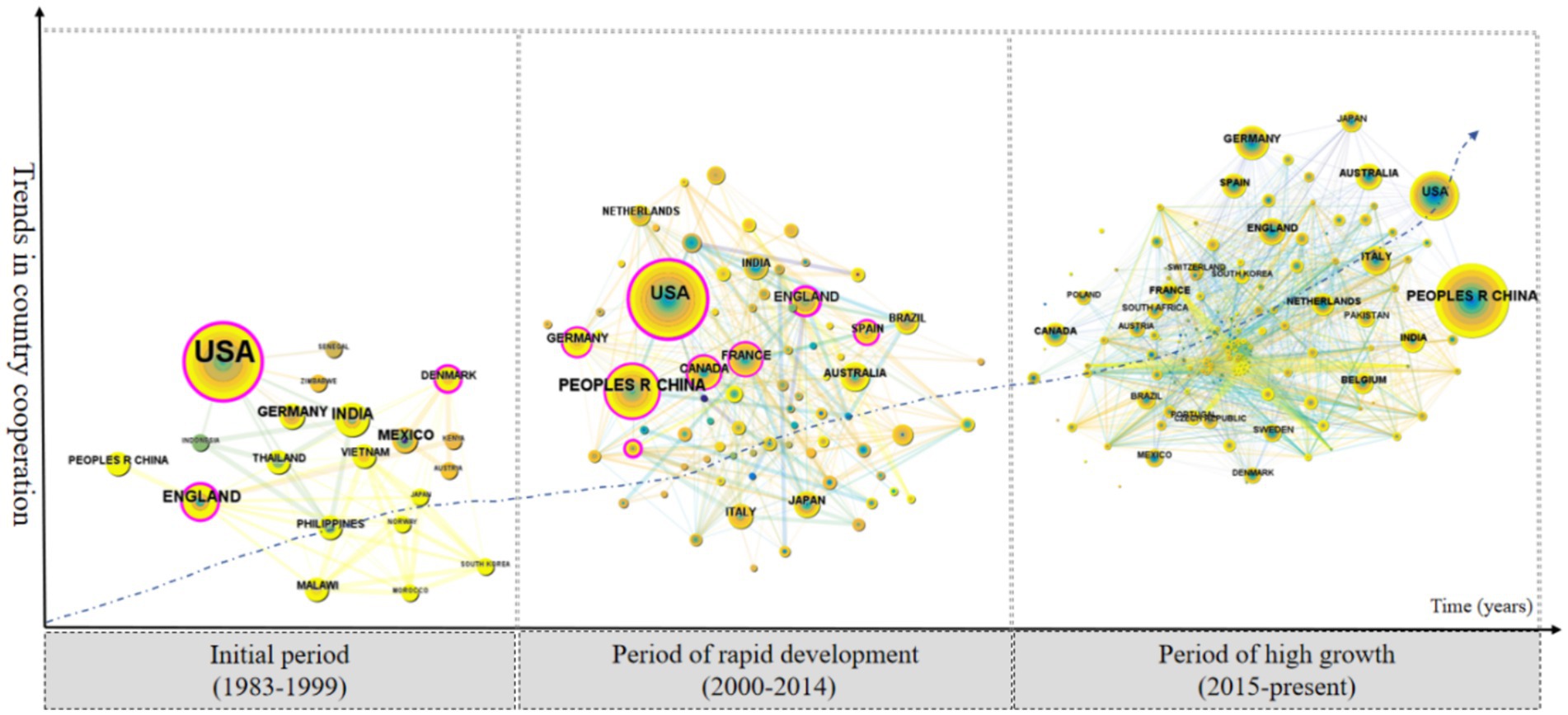
Figure 4. Trends in international collaboration during the initial, rapid development, and high-growth phases.
Although collaboration among developing countries remains relatively infrequent, its potential to foster meaningful partnerships should not be underestimated (Figure 5). Nations such as India, Brazil, and South Africa have progressively strengthened their research influence in this domain through strategic collaborations with developed countries. For instance, India’s frequent collaboration with the United States (20 instances) and the United Kingdom (14 instances) underscores its growing prominence within the global academic network. Regional collaboration also plays a pivotal role, as evidenced by the strong partnerships between Argentina and Chile (11 instances) in South America and Austria and Germany (26 instances) in Europe, highlighting the interconnected nature of regional research ecosystems. Moving forward, developing countries should prioritize strengthening intra-regional cooperation while simultaneously deepening academic exchanges with developed nations to collectively address the complex challenges posed by urban expansion’s impact on food production. Global academic collaboration is shaped by the dominant roles of developed countries and the rising influence of emerging economies and developing nations. Future research efforts should emphasize international cooperation, particularly by fostering collaborative innovation among developing countries, to facilitate the integration and exchange of global academic resources and drive sustainable advancements in the IUF field.
MCP (Number of papers co-authored by authors from different countries), SCP (Number of papers co-authored by authors from the same country), and MCP% (Percentage of MCP out of all papers) metrics indicate the number of co-authored publications between scholars from a specific country and those from other countries (Figure 6). The data show that China, the United States, and Germany exhibit the highest MCP values, with 332, 136, and 64 co-authored papers, respectively. Similarly, China, the United States, and Italy rank highest in SCP, with 623, 272, and 71 co-authored papers, respectively. China and the United States exert significant influence on both domestic and international academic collaboration networks within this domain. The United Kingdom, Australia, and Germany exhibit higher MCP percentages (57.9, 54.8, and 54.7%), whereas China and the United States, despite their top positions in SCP and MCP, have lower percentages (34.8 and 33.3%, respectively). Strengthening cross-border research collaboration between China and the United States has the potential to advance scientific understanding and contribute to research progress on the impact of urban expansion on food production.

Figure 6. Co-authorship of research papers by country collaboration (top 10 countries). The units for MCP and SCP are papers, while MCP% is expressed as a percentage.
3.2.2 Institutional situation analysis
From 1983 to early December 2024, a strong collaborative network emerged among institutions engaged in IUF research (Figure 7). The Centre National de la Recherche Scientifique (CNRS), the Chinese Academy of Sciences (CAS), and the United States Department of Agriculture (USDA) exhibit higher centrality scores of 0.08, 0.07, and 0.07, respectively, indicating their frequent establishment of collaborative ties with other institutions and their significant influence within the research community. CNRS collaborates closely with institutions like the University of Freiburg, the Swiss Federal Institute for Forestry, and the Potsdam Institute for Climate Impact Research. Recently, CAS has strengthened its connections with Purdue University, the Institute of Remote Sensing & Digital Earth, Université Paris-Saclay, Peking University, and others.
3.2.3 Author situation analysis
From the measurement results, it is evident that 16,120 authors have contributed to studies on the impact of urban expansion on food production. Applying the Lotka curve illustrates the distribution of authors by productivity more distinctly. As depicted in Figure 8, the majority of authors have published a small number of papers, with only a minority publishing more extensively in this field. Specifically, 13,500 authors, representing 83.7% of the total, have authored a single paper, while fewer than 100 authors have published six or more papers; for instance, only 89 authors, or 0.6%, have written six papers.
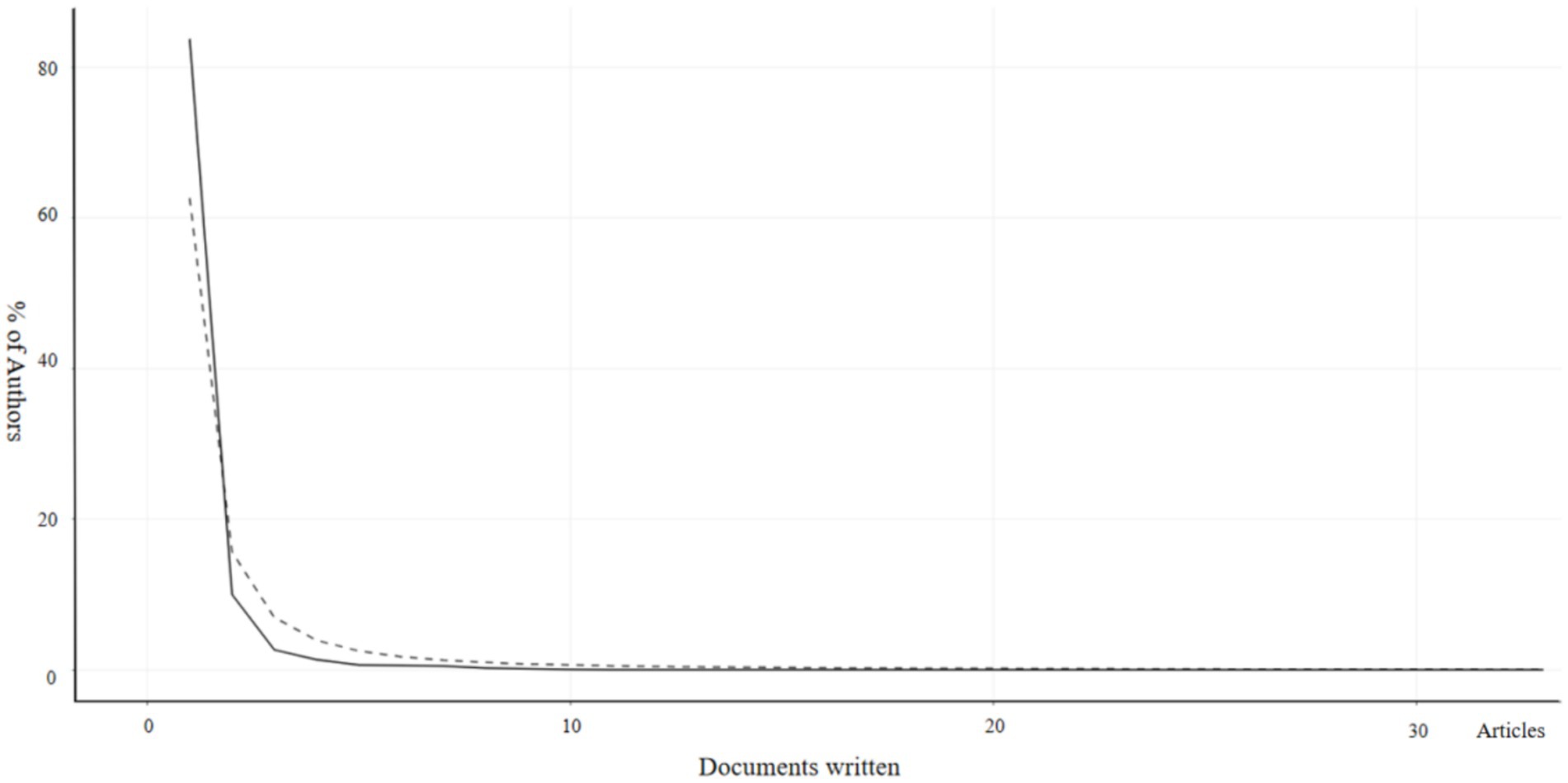
Figure 8. Lotka’s law curve in the field of the IUF. The horizontal axis represents the number of papers written by authors, measured in units of articles. The vertical axis indicates the percentage of authors who have published the corresponding number of papers.
In the realm of urban expansion’s impact on food production, Zhang Y, Zhu YG, and Ciais P emerge as pivotal researchers wielding considerable academic influence (refer to Table 4). In the context of the h-index (assessing the volume and impact of researchers’ scholarly output), Zhang Y, Zhu YG, and Ciais P are distinguished by their high citation counts, with respective indices of 17, 16, and 15. The g-indexes for Zhang Y, Li Y, and Wang J are 33, 28, and 26, respectively, indicating a substantial body of highly cited works by these scholars. As detailed in Table 4, Li Y and Zhang Y initiated their research in this domain earlier than their peers, commencing in 2005. Furthermore, the publication count for these two individuals is somewhat greater than that of their counterparts, having authored 33 and 28 papers, respectively.
3.3 Research hotspots
3.3.1 Keyword analysis
Co-occurrence analysis of keywords is a method used to identify dynamic themes and hotspots within a research field. The co-occurrence network depicted in Figure 9 consists of 870 nodes, 4,786 edges, and exhibits a network density of 0.0127. The terms “growth,” “climate change,” “management,” “crops,” “land use change,” and “food security” emerge as key terms in the realm of urban sprawl’s impact on food production. Specifically, “growth” appeared 484 times between 1983 and early November 2024, while “climate change,” “food security,” “yield,” and “management” were mentioned 249, 209, 201, and 193 times, respectively. The higher the mediational centrality of a keyword, the more significant its role in bridging different topics. Keywords with a mediational centrality exceeding 0.05 include “growth” (0.31), “food security” (0.06), and “carbon” (0.06), suggesting that scholars are increasingly focusing on aspects such as carbon and food security in their research. Keywords associated with “carbon” include “field,” “cation exchange capacity,” “accumulation,” and “plants,” among others. In the context of urban expansion, LUCC can influence the physico-chemical properties of agricultural soils, thereby impacting food production. This is intricately linked to the dynamics of soil carbon.
To further explore the research hotspots and thematic structure of the field, this study conducted a co-occurrence analysis of author keywords using VOSviewer (Figure 10). The results indicate that research in this field primarily revolves around the core themes of food security, climate change, sustainability, land use, and urban agriculture. Consistent with the findings from CiteSpace’s keyword co-occurrence analysis, food security and climate change remain central within the network, while growth and land use change also exhibit strong influence.
Keyword clustering analysis is instrumental in delineating prevalent themes within a research domain (Geng et al., 2024) with the IUF field yielding eight primary clusters (Figure 11). Clusters #0 (photosynthesis) #4 (soil) and #2 (urban agriculture) emerged as the initial clusters on the timeline ranging from 1983 to early December 2024 indicative of these topics being among the first research areas explored.
Since 2005, the areas of #1 (ecosystem services) and #3 (food waste) have emerged as rapidly expanding research topics; #11 (ecosystem services) encompasses keywords including ecosystem services, scenario analysis, afforestation program, urban sustainability, food security, and weather. The #3 (food waste) features terms including food waste management, circular economy, dairy waste valorization, organic amendments, and sustainable agriculture.
3.3.2 Burst analysis
Keyword burst analysis identifies fluctuations in the frequency of specific keywords over a given time frame and serves as an indicator for forecasting research trends and frontiers (Zhou et al., 2018). Figure 12 and Table 5 displays the keywords that CiteSpace software identified as experiencing burst occurrences from 1980 to early December 2024 along with their intensity and duration of these bursts. In terms of burst intensity the keyword with the highest score (6.89) is “growth” persisting from 2007 to 2013 signifying a significant focus on “growth” during this timeframe. Regarding the duration the keyword with the longest timeline is “air pollution” exhibiting a burst intensity of 6.84 from 1992 to 2014 spanning 22 years. Moreover, the terms “soil” “yield” “food” and “vegetation” are pivotal in this field of research. Figure 11 indicates that “soil” is the earliest cluster identified on the timeline; however, the term has experienced a significant surge in interest since 2008 potentially associated with advancements in agricultural and environmental sciences. “scenarios” “economic growth” and “availability” are emerging as current hot topics within the field.

Figure 12. Burst analysis of keywords in the IUF field. The bar chart illustrates the emergence and burst periods of keywords. The entire period is represented in blue, while the burst periods for each keyword are highlighted in red, indicating the start and end of each burst interval.
3.3.3 Highly cited analysis
Highly cited literature serves as a crucial indicator of research hotspots, as illustrated in Table 6. By conducting a thorough analysis of the research directions, methodologies, and conclusions presented within these pieces of literature, one can uncover emerging research trends. These insights offer valuable clues for further exploration and expansion of the existing research hotspots, facilitating a more in-depth and comprehensive understanding of the field. Overall, the GC (Global Citations) of each piece of literature is higher than its LC (Local Citations). This indicates that these literatures have received considerable attention and citations beyond the field of IUF, demonstrating a broader academic influence.
The GC of the paper “China and India lead in greening of the world through land-use management” (Table 6, Article 21) is the highest among the top 25 highly cited documents in the IUF field, reaching 1,819 times. Following it are “Future urban land expansion and implications for global croplands” (Table 6, Article 1) and “Rapid urbanization in China: A real challenge to soil protection and food security” (Table 6, Article 4), with their GC counts reaching 786 times and 695 times, respectively. The paper with the highest LC is “Future urban land expansion and implications for global croplands,” which reaches 69 times. Next are “Estimation of human induced disturbance of the environment associated with 2002, 2008 and 2013 land use/cover patterns in Mexico” published in 2014 (with 35 local citations) and “A global analysis of land take in cropland areas and production displacement from urbanization” published in 2017 (with 34 local citations).
4 Discussion
4.1 Evolution of the IUF in different periods of development
Exploring the evolution of urban sprawl’s impact on food production across various developmental stages is crucial for delineating the field’s progression and establishing a benchmark for future research. The analysis of this study draws on the most cited works from each period, integrating them with identified research hotspots (Section 3.3), to illuminate the focal points of researchers’ interests during those times (refer to Table 6). In the early stages of the IUF field’s development, the volume of publications was minimal, and no articles were extensively cited. Our findings indicate that during this time, the research community primarily concentrated on the impact of air pollution on crop yields (Chameides et al., 1999; Schenone and Lorenzini, 1992). Air pollution is intricately connected to urban sprawl; for instance, regional haze is more prevalent in regions experiencing economic growth (Russell et al., 1999). This pollution can impact plant growth and physiology, subsequently diminishing food production.
The challenge that rapid urbanization presents to soil conservation and food security during periods of swift development is a key research focus, aligning with the findings depicted in Figure 12. The urbanization process has intensified the scarcity of agricultural land, while urban air pollution waste has heightened the risk of soil contamination, evident in the decline of soil availability for food production and the deterioration of soil quality (Chen, 2007). This raises the question of how to achieve a balance between economic development and food production about land resources, while maintaining ecological integrity, which has emerged as a central research issue of this era. To address these issues, numerous countries have developed relevant policies. The effectiveness of these farmland protection policies in mitigating the decline in food production due to the loss of arable land to urban expansion has also been investigated by scholars. Lichtenberg and Ding (2008) evaluated the effectiveness of cropland protection policies in China, discovering that farmland conversion is inefficient in rapidly urbanizing regions, primarily in coastal and select central provinces with more fertile soils. Song and Pijanowski (2014) similarly examined the influence of cultivated land balance (CLB) on the agricultural productivity of croplands. The system’s failures impact the supply and demand dynamics of agricultural land conversion, influencing the returns on such conversions. Ensuring food security is not solely dependent on preserving the quantity of arable land but also on enhancing its quality, a factor that assumes greater importance during urbanization. Additionally, issues such as agricultural pollution, the evaluation of agricultural productivity, the growth of urban agriculture, and the efficient use of resources emerged as key research areas during this time.
Numerous previous studies indicate that urban expansion significantly diminishes arable land, posing a threat to food security. During the period of rapid growth in the field of the IUF, the exploration of new agricultural production models has emerged as a key research focus. As reported by Van Delden et al. (2021), vertical farming facilitates the production of food in a manner that is resilient to climate change, with the potential to eliminate pesticide and fertilizer emissions and decrease land and water usage relative to traditional agricultural practices. This results in a higher yield from less land, thereby enhancing land use efficiency (Al-Kodmany, 2018; Muller et al., 2017). Security challenges resulting from urban sprawl through policy adjustments and enforcement persists. There is a growing emphasis on enhancing the quality and efficiency of arable land, which indicates a consistent research trajectory within the region (Liu and Zhou, 2021). For instance, China has developed a range of policies aimed at reinforcing the control over arable land use, optimizing land resource allocation, and ensuring robust support for food security and sustainable agricultural progress. Additionally, the interplay between ecosystem services and urban growth has been intensively investigated, with modeling, carbon sequestration, and greenhouse gas emissions emerging as prominent research themes (Lee et al., 2015; Wang J. et al., 2019). Furthermore, extensive simulation studies, including scenario simulation, which has recently surged in keyword analysis, have been conducted to forecast the future implications of urban sprawl on food production. This research aims to identify a balance between economic advancement and food security (Zhang et al., 2017).
4.2 Problems, hot spots and prospects in the IUF field
Investigation into the effects of urban sprawl on food production has increasingly become a critical subset of land use change and agricultural science studies, garnering widespread interest among scientists. Presently, the detrimental effects of urban expansion on food production are well-documented, prompting researchers to seek more innovative methods and agricultural systems to alleviate the food supply strain imposed by urbanization (Asirifi et al., 2023; Buckley et al., 2022; Zacharaki et al., 2024). However, several challenges persist in the realm of the IUF research: (1) While researchers employ methods like machine learning and crop simulation models to quantify the impact of urbanization on regional cropland productivity and food production, the significant variability in cropland conditions across regions presents a considerable challenge in enhancing the portability of these models. For example, in some mountainous areas, due to the large topographic relief, traditional crop simulation models constructed based on data from plain areas are difficult to accurately estimate the productivity of cultivated land; (2) Urban development can be guided by identifying high-yield areas through crop cultivation suitability assessments. However, the selection and integration of model indicators are frequently subject to researcher bias, leading to varied outcomes; (3) There exists a gap between the “high-level policy design” and the “on-the-ground implementation” of agricultural policies. For instance, in China, policymakers enforce a policy of offsetting arable land occupation with replenishment to maintain food security. Yet, during execution, urban expansion often seizes prime agricultural land near cities, whereas the newly added arable land tends to be of inferior quality and located in environmentally fragile areas (Deng et al., 2024). This not only affects the food production capacity but also poses a potential threat to the ecological environment, highlighting the problems of lacking effective supervision and refined management in the process of policy implementation; (4) Urban sprawl is indeed a significant factor influencing food production, yet many of its indirect impacts remain unconsidered.
From the land use change and carbon cycle perspective, urban expansion sees a large quantity of cultivated land being occupied by urban construction, causing land use type changes. This significantly impacts the soil’s physical and chemical properties and the carbon cycle. Future research should concentrate on quantifying soil carbon’s source sink effects under different urban expansion models and the long-term influence of soil carbon dynamics on food production. At the ecosystem level, the synergistic link between ensuring food production and maintaining ecosystem services during urban expansion has drawn much attention. Future research can explore the application of ecological compensation in the coordinated development of urban and agricultural ecosystems. Building green infrastructure and improving farmland ecological environment can help achieve urban sustainable development and food security. Regarding food consumption, the “food waste” cluster shows the potential of food waste management and circular economy models in food production. Urban expansion leads to population concentration, which may cause serious food waste during consumption. In the future, exploring the conversion of food waste into useful resources (like promoting composting and returning it to farmland in rural areas near cities) and creating a circular economy model for food production and consumption are likely to be research hotspots in this field. Furthermore, terms like “scenarios” and “economic growth” suggest that analyzing the collaborative development strategies of urban expansion and food production based on multi-scenario analysis is highly significant. Under different economic development models, population growth trends, and policy directions, urban expansion affects food production differently. In the future, by combining factors such as urban planning and industrial layout, various urban expansion scenarios should be developed to analyze food production’s changing trends and challenges under different scenarios.
Future research endeavors might address the following aspects as the relevant field advances. (1) Enhancing model portability can be achieved by reinforcing interdisciplinary collaboration and merging insights from geography, agronomy, computer science, and additional disciplines. The introduction of standardization and modularization principles is proposed to collaboratively create more flexible and versatile models; (2) Assessing the interplay between economic growth and food production amidst urbanization. Intensify studies on the sustainability of food systems and investigate strategies for harmonizing economic, social, and environmental progress, concurrently ensuring food security; (3) An adaptable optimization target strategy can be developed. The appropriate direction and magnitude of urban growth, as well as the preservation of agricultural land, are dictated by considering variables like terrain, climate, and water resource availability across various regions; (4) Investigations into smart farming techniques can be intensified. The deployment of smart agricultural practices can tackle the issues posed by confined urban areas and scarce resources, enhancing both the productivity and sustainability of urban food systems. Intelligent agriculture, vertical farming, and rooftop farming present clear benefits regarding land utilization, water management, and agricultural production methods (Drottberger et al., 2023; Van Delden et al., 2021); the mechanisms by which these benefits enhance food production merit in-depth investigation by researchers. Figures 4, 5 illustrates the significant roles played by the United States and China in the realm of the IUF, yet there is a need to enhance their connections with international counterparts. Consequently, fostering interdisciplinary partnerships, encouraging international academic exchanges, and incorporating novel ideas from diverse disciplines are essential for promoting resource sharing and speeding up the progression of the field.
Additionally, incorporating text mining and machine learning algorithms could enable a deeper analysis of literature content, improving both the accuracy and comprehensiveness of the findings. For topic analysis, text mining techniques such as Natural Language Processing (NLP) and Latent Dirichlet Allocation (LDA) topic modeling can be employed to automatically extract research hotspots, track research trends at different stages of development, and uncover convergence patterns in interdisciplinary research. In terms of trend prediction, deep learning models (e.g., Long Short-Term Memory (LSTM) and Transformer) can be utilized to train time-series forecasting models based on historical literature data, enabling the identification of potential future research directions. By leveraging these methods, researchers can systematically explore the evolutionary trajectories of disciplines, optimize research resource allocation, and provide policymakers with more forward-looking, evidence-based decision support.
4.3 Implications for urban planning and food security policy
The findings of this study have significant implications for urban planners, policymakers, and food security stakeholders. As urban expansion increasingly encroaches upon agricultural land, strategic urban planning and evidence-based policy interventions are essential to mitigating its adverse effects on food production. The identification of research hotspots underscores the urgency of policy-driven solutions, particularly in addressing land-use conflicts and promoting sustainable agricultural practices.
City planners can leverage insights from this study to implement compact urban growth models, integrate green infrastructure planning, and develop land-use zoning policies that prioritize agricultural preservation. Additionally, incorporating peri-urban agriculture into urban development plans can help sustain food production capacity while accommodating population growth. Governments can utilize these findings to design targeted interventions, such as subsidies for sustainable farming practices, farmland protection laws, and adaptive agricultural policies aimed at enhancing productivity in urbanizing regions. Moreover, promoting technological innovations—including precision agriculture and vertical farming—could help offset production losses caused by urbanization.
To bridge the gap between research and policy, future efforts should focus on embedding geospatial analysis into urban and agricultural policy frameworks. Encouraging cross-sector collaboration among urban planners, environmental scientists, and agricultural policymakers can foster more holistic solutions for balancing urban growth with food security needs.
4.4 Limitations of this research
During the research, data sources were only from the Web of Science Core Database. Data from authoritative databases in various countries (such as CNKI) were not included. This caused an incomplete data sample, leading to biases in regions and research focuses. To minimize bias arising from data limitations, we adopt a cautious approach in our analysis and avoid overgeneralization. For instance, when identifying research hotspots and forecasting trends, we derive conclusions solely from stable and highly cited literature, refraining from making definitive inferences about underrepresented data segments. Based on our understanding and analysis of the current state of research, as well as our reflection on the limitations of this study, we propose several directions for future research: (1) Broadening data sources: Future studies should integrate literature from multiple databases to comprehensively cover research from different regions and languages, thereby enhancing the richness and representativeness of the data. (2) Deepening research perspectives: Further exploration is needed to understand the complex mechanisms by which urban expansion affects food production.
5 Conclusion
In this literature review, we searched for scholarly articles examining the influence of urban sprawl on food production within the domain of ecological risks associated with land use changes, spanning from 1980 until the beginning of December 2024. We utilized the Web of Science core database and employed data mining techniques using the bibliometric tools CiteSpace, VOSviewer and Bibliometrix R-tool. Our objective was to conduct a quantitative analysis of the research landscape in this area. The citation analysis findings reveal the evolution of the IUF field, which can be segmented into three stages: the initial phase (1983–1999), the phase of rapid growth (2000–2014), and the current high-growth phase (2015–present). Furthermore, there has been a notable rise in researchers’ focus on the IUF domain in recent times. During the high-growth phase, the mean MTC value is 6.27, suggesting that the research outcomes are gaining credibility and have a broader impact. A collective effort from 139 nations has contributed to research in the IUF domain, with publications such as the Journal of Cleaner Production, Sustainability, and Science of the Total Environment serving as key academic outlets. Studies encompassing environmental science, sustainable development, ecology, and associated social sciences underscore the interdisciplinary nature and the varied scope of research in this field.
The influence of urban sprawl on food production has garnered increased focus in line with the deepening inquiry into global land-use transformation and sustainable farming practices. Beyond ongoing investigations into central themes such as crop productivity, land-use shifts, and food security, recent years have seen a surge in interest in greenhouse gas emissions, predictive modeling, carbon footprint analysis, and the development of smart agricultural technologies as key research focal points. Determining the balance between economic growth and food production amidst urbanization is a key priority for future scholarly inquiry. By delving into the realm of the IUF, we can significantly address the challenge of global food security. Furthermore, strategies for the efficient use of land resources and the advancement of sustainable agricultural practices must also be central to upcoming research efforts.
Data availability statement
The original contributions presented in the study are included in the article/Supplementary material, further inquiries can be directed to the corresponding author.
Author contributions
CC: Conceptualization, Data curation, Formal analysis, Investigation, Methodology, Resources, Software, Validation, Visualization, Writing – original draft. JW: Funding acquisition, Project administration, Software, Supervision, Writing – review & editing.
Funding
The author(s) declare that financial support was received for the research and/or publication of this article. This work was supported by the National Natural Science Foundation of China (Grant no. 42371271).
Conflict of interest
The authors declare that the research was conducted in the absence of any commercial or financial relationships that could be construed as a potential conflict of interest.
Generative AI statement
The authors declare that no Gen AI was used in the creation of this manuscript.
Publisher’s note
All claims expressed in this article are solely those of the authors and do not necessarily represent those of their affiliated organizations, or those of the publisher, the editors and the reviewers. Any product that may be evaluated in this article, or claim that may be made by its manufacturer, is not guaranteed or endorsed by the publisher.
Supplementary material
The Supplementary material for this article can be found online at: https://www.frontiersin.org/articles/10.3389/fsufs.2025.1550373/full#supplementary-material
Reference
Al-Kodmany, K. (2018). The vertical farm: a review of developments and implications for the vertical city. Buildings 8:24. doi: 10.3390/buildings8020024
Andrade, J. F., Cassman, K. G., Rattalino Edreira, J. I., Agus, F., Bala, A., Deng, N., et al. (2022). Impact of urbanization trends on production of key staple crops. Ambio 51, 1158–1167. doi: 10.1007/s13280-021-01674-z
Aria, M., and Cuccurullo, C. (2017). Bibliometrix: an R-tool for comprehensive science mapping analysis. J. Informet. 11, 959–975. doi: 10.1016/j.joi.2017.08.007
Asirifi, I., Kaetzl, K., Werner, S., Heinze, S., Abagale, F. K., Wichern, M., et al. (2023). Biochar for wastewater treatment and soil improvement in irrigated urban agriculture: single and combined effects on crop yields and soil fertility. J. Soil Sci. Plant Nutr. 23, 1408–1420. doi: 10.1007/s42729-023-01132-7
Bassu, S., Brisson, N., Durand, J. L., Boote, K., Lizaso, J., Jones, J. W., et al. (2014). How do various maize crop models vary in their responses to climate change factors? Glob. Chang. Biol. 20, 2301–2320. doi: 10.1111/gcb.12520
Bornmann, L., and Marx, W. (2012). HistCite analysis of papers constituting the h index research front. J. Informet. 6, 285–288. doi: 10.1016/j.joi.2011.11.001
Bren d’Amour, C., Reitsma, F., Baiocchi, G., Barthel, S., Güneralp, B., Erb, K. H., et al. (2017). Future urban land expansion and implications for global croplands. Proc. Natl. Acad. Sci. 114, 8939–8944. doi: 10.1073/pnas.1606036114
Buckley, S., Sparks, R., Cowdery, E., Stirling, F., Marsching, J., and Phillips, N. (2022). Enhancing crop growth in rooftop farms by repurposing CO2 from human respiration inside buildings. Front. Sustain. Food Syst. 6:918027. doi: 10.3389/fsufs.2022.918027
Chameides, W. L., Yu, H., Liu, S. C., Bergin, M., Zhou, X., Mearns, L., et al. (1999). Case study of the effects of atmospheric aerosols and regional haze on agriculture: an opportunity to enhance crop yields in China through emission controls? Proc. Natl. Acad. Sci. 96, 13626–13633. doi: 10.1073/pnas.96.24.13626
Chen, J. (2007). Rapid urbanization in China: a real challenge to soil protection and food security. Catena 69, 1–15. doi: 10.1016/j.catena.2006.04.019
Chen, C., (2018). Visualizing and exploring scientific literature with Citespace: an introduction, Proceedings of the 2018 conference on human information interaction & retrieval, pp. 369–370.
Chen, G., Li, X., Liu, X., Chen, Y., Liang, X., Leng, J., et al. (2020). Global projections of future urban land expansion under shared socioeconomic pathways. Nat. Commun. 11:537. doi: 10.1038/s41467-020-14386-x
Chen, J., Liu, X., Zhou, S., and Kang, J. (2023). Knowledge mapping analysis of resilient shipping network using CiteSpace. Ocean Coast. Manag. 244:106775. doi: 10.1016/j.ocecoaman.2023.106775
Chen, C., Song, I.-Y., Yuan, X., and Zhang, J. (2008). The thematic and citation landscape of data and knowledge engineering (1985–2007). Data Knowl. Eng. 67, 234–259. doi: 10.1016/j.datak.2008.05.004
Cheng, P., Tang, H., Lin, F., and Kong, X. (2023). Bibliometrics of the nexus between food security and carbon emissions: hotspots and trends. Environ. Sci. Pollut. Res. 30, 25981–25998. doi: 10.1007/s11356-022-23970-1
da Encarnação Paiva, A. C., Nascimento, N., Rodriguez, D. A., Tomasella, J., Carriello, F., and Rezende, F. S. (2020). Urban expansion and its impact on water security: the case of the Paraíba do Sul River basin, São Paulo, Brazil. Sci. Total Environ. 720:137509:137509. doi: 10.1016/j.scitotenv.2020.137509
De Bem Machado, A., Secinaro, S., Calandra, D., and Lanzalonga, F. (2022). Knowledge management and digital transformation for industry 4.0: a structured literature review. Knowl. Manag. Res. Pract. 20, 320–338. doi: 10.1080/14778238.2021.2015261
de Castilhos Ghisi, N., Zuanazzi, N. R., Fabrin, T. M. C., and Oliveira, E. C. (2020). Glyphosate and its toxicology: a scientometric review. Sci. Total Environ. 733:139359. doi: 10.1016/j.scitotenv.2020.139359
Deng, X., Xu, X., Cai, H., and Li, J. (2024). Assessment the impact of urban expansion on cropland net primary productivity in Northeast China. Ecol. Indic. 159:111698. doi: 10.1016/j.ecolind.2024.111698
Ding, L., Zhao, Z., and Wang, L. (2022). A bibliometric review on institutional investor: current status, development and future directions. Manag. Decis. 60, 673–706. doi: 10.1108/MD-09-2020-1302
Drottberger, A., Zhang, Y., Yong, J. W. H., and Dubois, M.-C. (2023). Urban farming with rooftop greenhouses: a systematic literature review. Renew. Sust. Energ. Rev. 188:113884. doi: 10.1016/j.rser.2023.113884
Gao, J., and O’Neill, B. (2020). Mapping global urban land for the 21st century with data-driven simulations and shared socioeconomic pathways. Nat. Commun. 11:2302. doi: 10.1038/s41467-020-15788-7
Garfield, E. (1964). “Science Citation Index”—A New Dimension in Indexing: This unique approach underlies versatile bibliographic systems for communicating and evaluating information. Science. 144, 649–654. doi: 10.1126/science.144.3619.649
Geng, Y., Jiang, X., Bai, W., Yan, Y., and Gao, J. (2024). Research progress of tourism marketing over 30 years: bibliometrics based on CiteSpace. Ecol. Indic. 162:112059. doi: 10.1016/j.ecolind.2024.112059
Gren, Å., and Andersson, E. (2018). Being efficient and green by rethinking the urban-rural divide—combining urban expansion and food production by integrating an ecosystem service perspective into urban planning. Sustain. Cities Soc. 40, 75–82. doi: 10.1016/j.scs.2018.02.031
He, C., Liu, Z., Xu, M., Ma, Q., and Dou, Y. (2017). Urban expansion brought stress to food security in China: evidence from decreased cropland net primary productivity. Sci. Total Environ. 576, 660–670. doi: 10.1016/j.scitotenv.2016.10.107
Huang, L., Zhou, M., Lv, J., and Chen, K. (2020). Trends in global research in forest carbon sequestration: a bibliometric analysis. J. Clean. Prod. 252:119908. doi: 10.1016/j.jclepro.2019.119908
Lee, G.-G., Lee, H.-W., and Lee, J.-H. (2015). Greenhouse gas emission reduction effect in the transportation sector by urban agriculture in Seoul, Korea. Landsc. Urban Plan. 140, 1–7. doi: 10.1016/j.landurbplan.2015.03.012
Li, G., Fang, C., Li, Y., Wang, Z., Sun, S., He, S., et al. (2022). Global impacts of future urban expansion on terrestrial vertebrate diversity. Nat. Commun. 13:1628. doi: 10.1038/s41467-022-29324-2
Li, B., Hu, K., Lysenko, V., Khan, K. Y., Wang, Y., Jiang, Y., et al. (2022). A scientometric analysis of agricultural pollution by using bibliometric software VoSViewer and Histcite™. Environ. Sci. Pollut. Res. 29, 37882–37893. doi: 10.1007/s11356-022-18491-w
Li, S., Ji, Q., Liang, W., Fu, B., Lü, Y., Yan, J., et al. (2023). Urbanization does not endanger food security: evidence from China's loess plateau. Sci. Total Environ. 871:162053. doi: 10.1016/j.scitotenv.2023.162053
Li, Y., Li, X., Tan, M., Wang, X., and Xin, L. (2018). The impact of cultivated land spatial shift on food crop production in China, 1990–2010. Land Degrad. Dev. 29, 1652–1659. doi: 10.1002/ldr.2929
Li, Y., Shen, J., Xia, C., Xiang, M., Cao, Y., and Yang, J. (2021). The impact of urban scale on carbon metabolism--a case study of Hangzhou, China. J. Clean. Prod. 292:126055:126055. doi: 10.1016/j.jclepro.2021.126055
Li, W., Wang, J., Chen, C., Xia, J., Niu, Y., Yu, Z., et al. (2024). Advancements and trends in ecological models for lake ecosystems: a bibliometric analysis (2002–2022). Ecohydrology 17:e2655. doi: 10.1002/eco.2655
Lichtenberg, E., and Ding, C. (2008). Assessing farmland protection policy in China. Land Use Policy 25, 59–68. doi: 10.1016/j.landusepol.2006.01.005
Liu, Z., Yang, Z., Chen, M., Xu, H., Yang, Y., Zhang, J., et al. (2023). Research hotspots and frontiers of mountain flood disaster: bibliometric and visual analysis. Water 15:673. doi: 10.3390/w15040673
Liu, Y., and Zhou, Y. (2021). Reflections on China's food security and land use policy under rapid urbanization. Land Use Policy 109:105699. doi: 10.1016/j.landusepol.2021.105699
Long, L., Bai, J., Xie, T., Xiao, C., Zhang, G., and Chen, G. (2024). Living estuarine shorelines as nature-based green engineering for coastal stabilization: a scientometric analysis. Ecol. Eng. 208:107361. doi: 10.1016/j.ecoleng.2024.107361
Lotka, A. J. (1926). The frequency distribution of scientific productivity. J. Wash. Acad. Sci. 16, 317–323.
Muller, A., Ferré, M., Engel, S., Gattinger, A., Holzkämper, A., Huber, R., et al. (2017). Can soil-less crop production be a sustainable option for soil conservation and future agriculture? Land Use Policy 69, 102–105. doi: 10.1016/j.landusepol.2017.09.014
Munton, R. (2009). Rural land ownership in the United Kingdom: changing patterns and future possibilities for land use. Land Use Policy 26, S54–S61. doi: 10.1016/j.landusepol.2009.08.012
Nadoushan, M. A. (2022). Advancing urban planning in arid agricultural-urbanized landscapes of Iran: spatial modeling evidence from a rapidly developing region. Sustain. Cities Soc. 87:104230. doi: 10.1016/j.scs.2022.104230
Pan, X., Yan, E., Cui, M., and Hua, W. (2018). Examining the usage, citation, and diffusion patterns of bibliometric mapping software: a comparative study of three tools. J. Informet. 12, 481–493. doi: 10.1016/j.joi.2018.03.005
Peters, H., and Van Raan, A. (1991). Structuring scientific activities by co-author analysis: an expercise on a university faculty level. Scientometrics 20, 235–255. doi: 10.1007/BF02018157
Picone, F., Buonocore, E., Chemello, R., Russo, G. F., and Franzese, P. P. (2021). Exploring the development of scientific research on marine protected areas: from conservation to global ocean sustainability. Eco. Inform. 61:101200. doi: 10.1016/j.ecoinf.2020.101200
Rodríguez-Soler, R., Uribe-Toril, J., and Valenciano, J. D. P. (2020). Worldwide trends in the scientific production on rural depopulation, a bibliometric analysis using bibliometrix R-tool. Land Use Policy 97:104787. doi: 10.1016/j.landusepol.2020.104787
Russell, P., Hobbs, P., and Stowe, L. (1999). An overview of the tropospheric aerosol radiative forcing observational experiment (TARFOX). J. Geophys. Res. Atmos. 104, 2213–2222. doi: 10.1029/1998JD200028
Saini, S., Burman, R. R., Padaria, R. N., Mahra, G. S., Bishnoi, S., Aditya, K., et al. (2023). Mapping the research trends of migration behavior in agricultural households: a bibliometric analysis. Front. Sustain. Food Syst. 7:1241716. doi: 10.3389/fsufs.2023.1241716
Salvati, L. (2013). Monitoring high-quality soil consumption driven by urban pressure in a growing city (Rome, Italy). Cities 31, 349–356. doi: 10.1016/j.cities.2012.11.001
San-Juan-Heras, R., Gabriel, J. L., Delgado, M. M., Alvarez, S., and Martinez, S. (2024). Scientometric analysis of cover crop management: trends, networks, and future directions. Eur. J. Agron. 161:127355. doi: 10.1016/j.eja.2024.127355
Schenone, G., and Lorenzini, G. (1992). Effects of regional air pollution on crops in Italy. Agric. Ecosyst. Environ. 38, 51–59. doi: 10.1016/0167-8809(92)90166-9
Silvente, G. A., Ciupak, C., and Carneiro-da-Cunha, J. A. (2018). Top management teams: a bibliometric research from 2005 to 2015. Int. J. Manag. Decis. Mak. 17, 95–124. doi: 10.1504/IJMDM.2018.088822
Song, W., and Pijanowski, B. C. (2014). The effects of China's cultivated land balance program on potential land productivity at a national scale. Appl. Geogr. 46, 158–170. doi: 10.1016/j.apgeog.2013.11.009
Thebo, A. L., Drechsel, P., and Lambin, E. (2014). Global assessment of urban and peri-urban agriculture: irrigated and rainfed croplands. Environ. Res. Lett. 9:114002. doi: 10.1088/1748-9326/9/11/114002
United Nations. (2018). World urbanization prospects: the 2018 revision. Available online at: https://www.un.org/en/desa/2018-revision-world-urbanization-prospects (Accessed February 15, 2025).
Van Delden, S., SharathKumar, M., Butturini, M., Graamans, L. J., Heuvelink, E., Kacira, M., et al. (2021). Current status and future challenges in implementing and upscaling vertical farming systems. Nat. Food 2, 944–956. doi: 10.1038/s43016-021-00402-w
van Vliet, J., Eitelberg, D. A., and Verburg, P. H. (2017). A global analysis of land take in cropland areas and production displacement from urbanization. Glob. Environ. Chang. 43, 107–115. doi: 10.1016/j.gloenvcha.2017.02.001
Wang, X. (2020). Consumption of cropland with high yield and low irrigation water intensity by urban expansion in China during 2000–2015. Ecol. Indic. 117:106644. doi: 10.1016/j.ecolind.2020.106644
Wang, S., Bai, X., Zhang, X., Reis, S., Chen, D., Xu, J., et al. (2021). Urbanization can benefit agricultural production with large-scale farming in China. Nat. Food 2, 183–191. doi: 10.1038/s43016-021-00228-6
Wang, Y., van Vliet, J., Pu, L., and Verburg, P. H. (2019). Modeling different urban change trajectories and their trade-offs with food production in Jiangsu Province, China. Comput. Environ. Urban. Syst. 77:101355. doi: 10.1016/j.compenvurbsys.2019.101355
Wang, X., Zhang, Y., Zhang, J., Fu, C., and Zhang, X. (2021). Progress in urban metabolism research and hotspot analysis based on CiteSpace analysis. J. Clean. Prod. 281:125224. doi: 10.1016/j.jclepro.2020.125224
Wang, J., Zhou, W., Pickett, S. T., Yu, W., and Li, W. (2019). A multiscale analysis of urbanization effects on ecosystem services supply in an urban megaregion. Sci. Total Environ. 662, 824–833. doi: 10.1016/j.scitotenv.2019.01.260
Wei, Q., Wei, Q., Xu, J., Liu, Y., Wang, D., Chen, S., et al. (2024). Nitrogen losses from soil as affected by water and fertilizer management under drip irrigation: development, hotspots and future perspectives. Agric. Water Manag. 296:108791. doi: 10.1016/j.agwat.2024.108791
Xiao, F., Liu, Q., Qin, Y., Huang, D., and Liao, Y. (2024). Agricultural drought research knowledge graph reasoning by using VOSviewer. Heliyon 10:e27696. doi: 10.1016/j.heliyon.2024.e27696
Yang, D., and Song, W. (2023). Tracking land use trajectory to map abandoned farmland in mountainous area. Eco. Inform. 75:102103. doi: 10.1016/j.ecoinf.2023.102103
Yang, X., Zhang, S., and Luo, J. (2023). Plant phylogenetics: a bibliometric analysis based on VOSviewer and CiteSpace. Appl. Ecol. Environ. Res. 21, 3737–3754. doi: 10.15666/aeer/2104_37373754
Zacharaki, A. K., Monaghan, J. M., Bromley, J. R., and Vickers, L. H. (2024). Opportunities and challenges for strawberry cultivation in urban food production systems. Plants People Planet 6, 611–621. doi: 10.1002/ppp3.10475
Zhang, D., Huang, Q., He, C., and Wu, J. (2017). Impacts of urban expansion on ecosystem services in the Beijing-Tianjin-Hebei urban agglomeration, China: a scenario analysis based on the shared socioeconomic pathways. Resour. Conserv. Recycl. 125, 115–130. doi: 10.1016/j.resconrec.2017.06.003
Zhang, Y., Jia, Z., Wang, J., and Liang, H. (2024). Research hotspots and Frontiers of Alzheimer’s disease and gut microbiota: a knowledge mapping and text mining analysis. Mol. Neurobiol. 61, 9369–9382. doi: 10.1007/s12035-024-04168-7
Keywords: urban expansion, food production, food security, CiteSpace, Bibliometrix, VOSviewer
Citation: Cao C and Wang J (2025) The impact of urban expansion on food production: a bibliometric study of development, hotspots, and future prospects. Front. Sustain. Food Syst. 9:1550373. doi: 10.3389/fsufs.2025.1550373
Edited by:
Xueru Zhang, Hebei University of Economics and Business, ChinaReviewed by:
Pablo Torres-Lima, Metropolitan Autonomous University, MexicoMohammad Reza Khalilnezhad, University of Birjand, Iran
Shicheng Li, China University of Geosciences Wuhan, China
Shanfeng He, Qufu Normal University, China
Copyright © 2025 Cao and Wang. This is an open-access article distributed under the terms of the Creative Commons Attribution License (CC BY). The use, distribution or reproduction in other forums is permitted, provided the original author(s) and the copyright owner(s) are credited and that the original publication in this journal is cited, in accordance with accepted academic practice. No use, distribution or reproduction is permitted which does not comply with these terms.
*Correspondence: Jiayu Wang, MTExMzIwMjMxMjRAYm51LmVkdS5jbg==
 Congjie Cao
Congjie Cao Jiayu Wang1*
Jiayu Wang1*